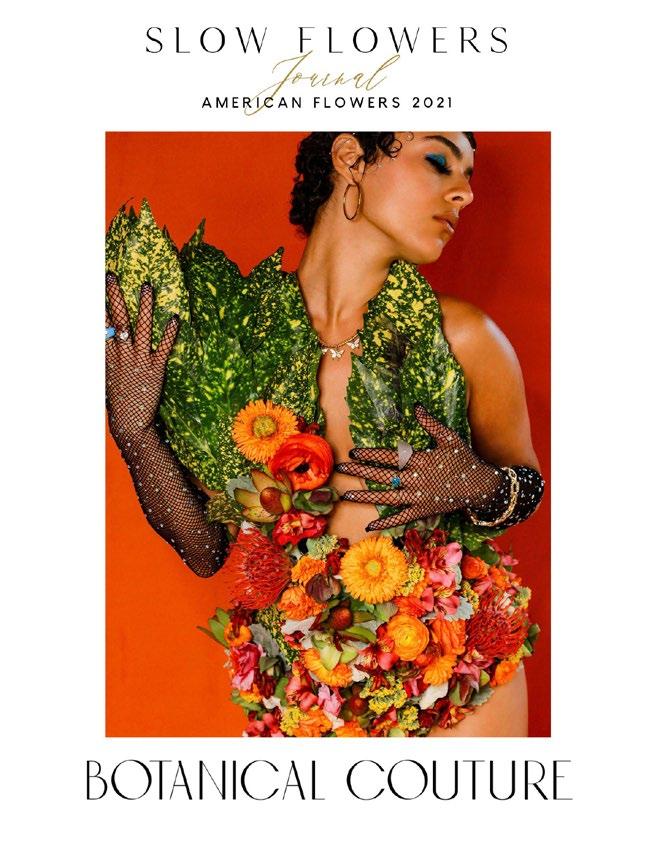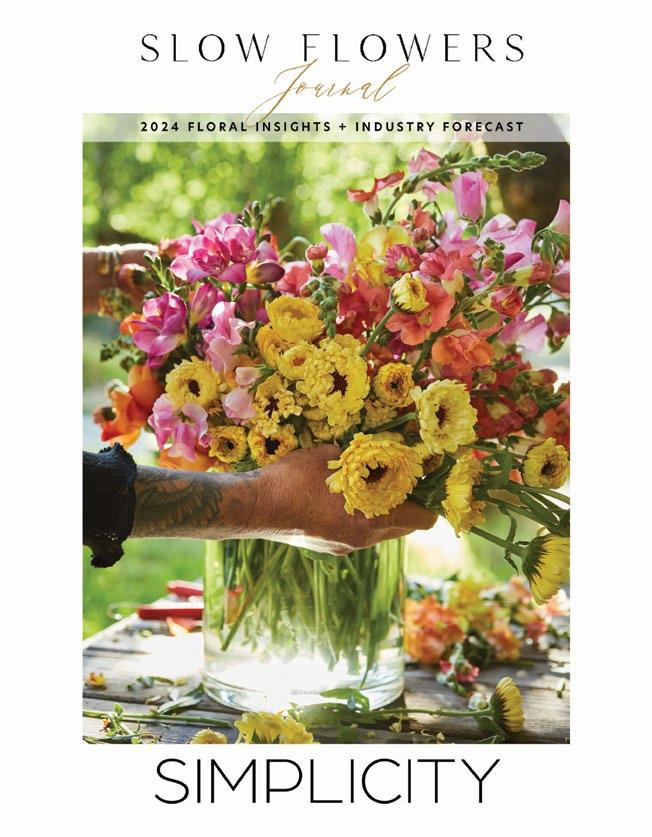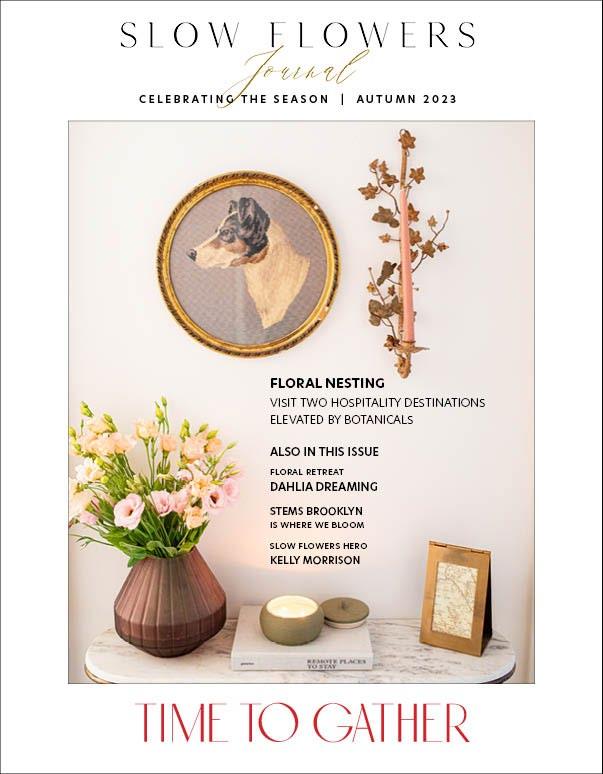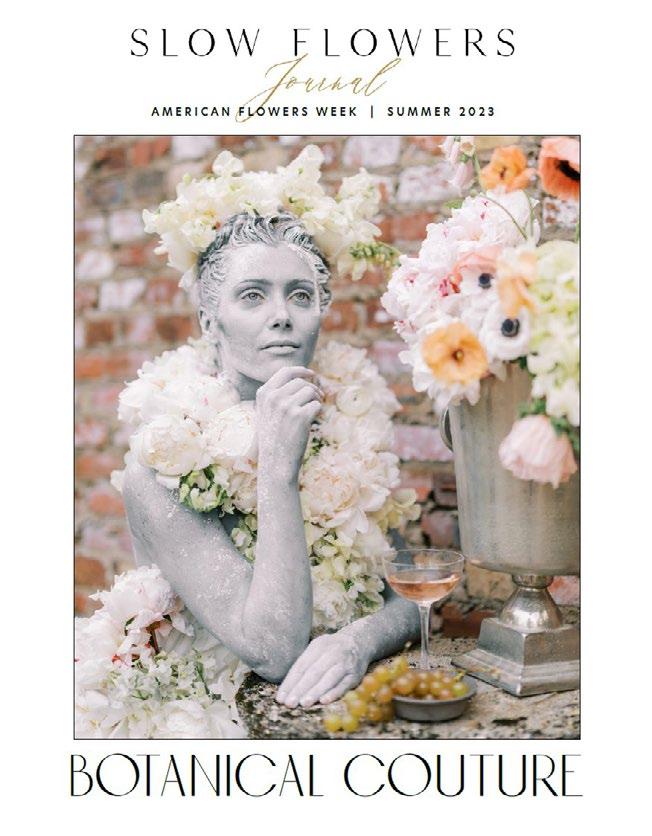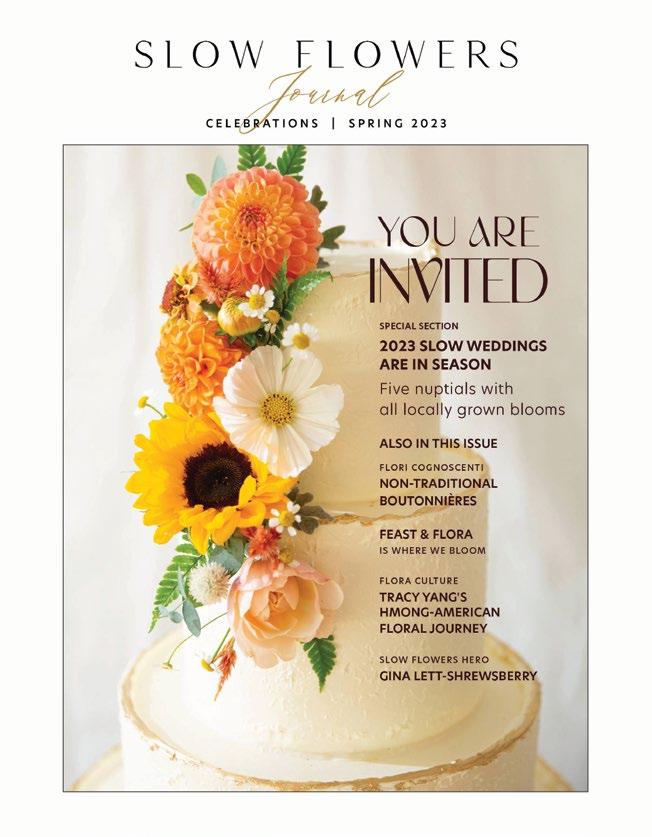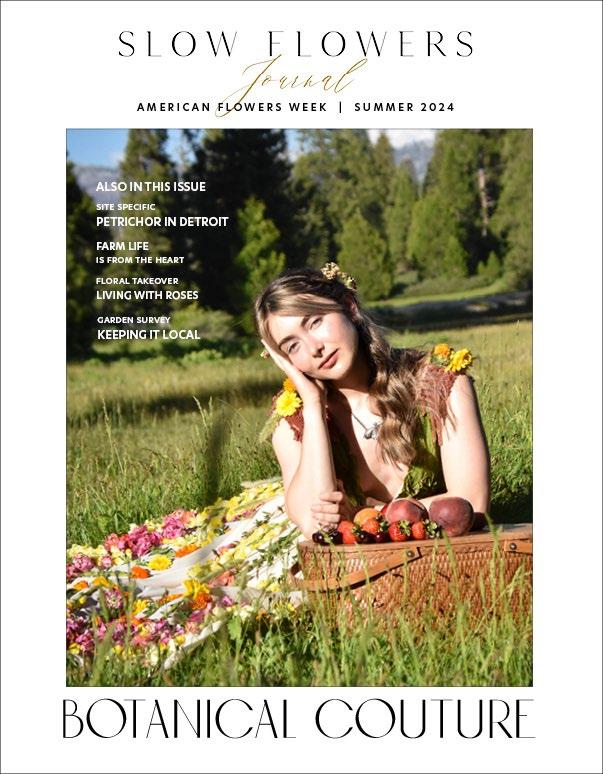




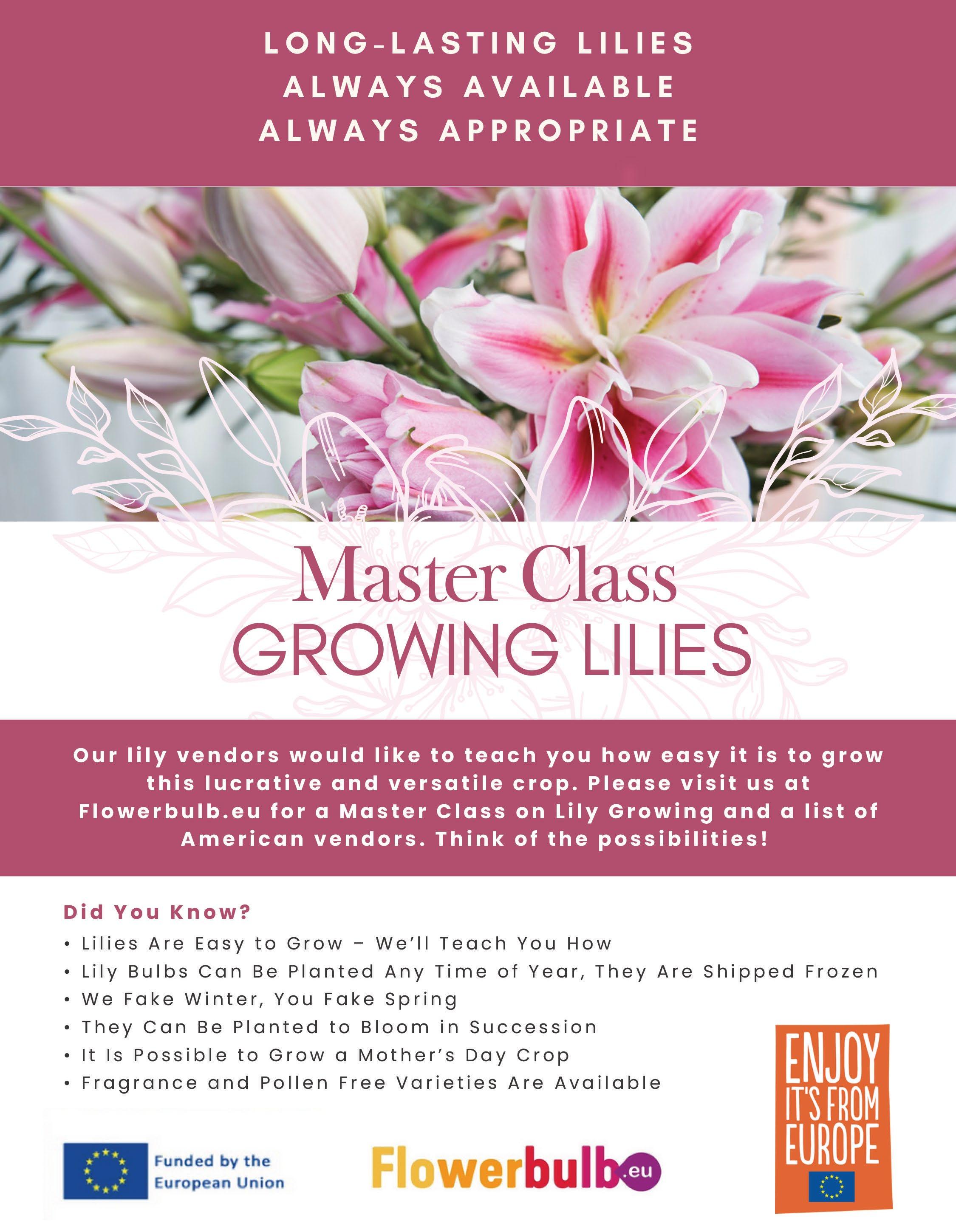


EDITORIAL DIRECTOR
Debra Prinzing
CREATIVE DIRECTOR
Robin Avni
COPY EDITOR
Brenda Silva
CONTRIBUTORS
David and Lina Brunton
PHOTOGRAPHERS
Brook Ashley, Xenia D’Ambrosi, Kristen Earley, Fausel Imagery, Fine and Fleurie, Jamie Horton Photography, Alana Karam, Darla Maxine Photography, Adam O’Neal, Lori Poliski, Kate Punnett, Katie Tolson, Jim Martin, Darryll Williams
ON THE COVER Rizaniño “Riz” Reyes of Seattle-based RHR Horticulture fashioned a gardenforaged spring posy composed of hellebore, fritillaria, Siberian bugloss (Brunnera), grape hyacinth, daffodils, rosemary, and daphne for its scent. Silver gray Brachyglottis, glossy Polystichum fern, and branches of flowering Ribes and bearberry hold the delicate flowers together.
Featured in The Flower Farmer: Inspiration & Advice from Expert Growers, by Debra Prinzing & Robin Avni (Abrams, 2025).
COVER PHOTOGRAPHER
Rizaniño “Riz” Reyes rhrhorticulture.com
© 2025 by SLOW FLOWERS JOURNAL and BLOOM Imprint. All rights reserved.
No part of this publication may be reproduced, stored in a retrieval system or transmitted, in any form or by any means, electronic, mechanical, photocopying, recording or otherwise, without prior written permission of the publisher.

As storytellers and journalists, we honed our craft in the newspaper and magazine worlds, Debra as an editor and reporter; Robin as a photography editor and creative director. We discovered that combining verbal and visual narratives feels like a perfect way to communicate lifestyle insights for the creative community and beyond. Our observations and insights rely on both the written word and the non-verbal imagery that accompanies it. That is the winning recipe to building an annual forecast, which we share with you here.
As we’ve said in the past, the ritual of compiling an annual “trend report” is as familiar as listing one’s New Year’s resolutions, but for those of us who watch consumer lifestyle changes, it can be an informative way to evaluate the direction of our individual floral businesses.
The insights you read here reflect a full year of primary and secondary research from both consumer and industry sources. Debra is inspired by her wide-ranging conversations with florists, growers, experts, influencers, makers, and educators. BLOOM Imprint's creative director, Robin, contributes her point of view and expertise in cultural and consumer trend-watching, applying timely lifestyle insights to share with you. We have gathered these impressions to identify seven floral lifestyle themes that are moving to the forefront of our awareness for the coming year.

David and Lina Brunton grow and deliver flowers in Anne Arundel County, Maryland. Right Field Farm is tucked into a forest near the Severn River, by the Chesapeake Bay, with the house situated near what was once the right field fence of a baseball diamond - hence the name. David and Lina grow a mix of annual and perennial flowers with an eye toward all the natural beauty that Maryland has to offer rightfieldfarm.com
RIZANIÑO “RIZ” REYES credits an early curiosity about fruits and flowers in his native Philippines and a lifelong obsession for rare and unusual plants for inspiring his thriving horticultural career. He moved with his family to the Pacific Northwest at age seven, where Riz began to learn the names of the new and strange flowers and later nurture his love of horticulture —”the art and science of plants” — at the University of Washington. Of his work, he says he hopes to inspire more young people, “especially people of color, to be involved with interacting with nature and learning about the environment.” Through RHR Horticulture, he gardens, teaches, designs, and grows cut flowers. Riz is the author of a popular children’s book, GROW, a Family Guide to Plants and How to Grow Them (Harry N. Abrams, 2022). rhrhorticulture.com

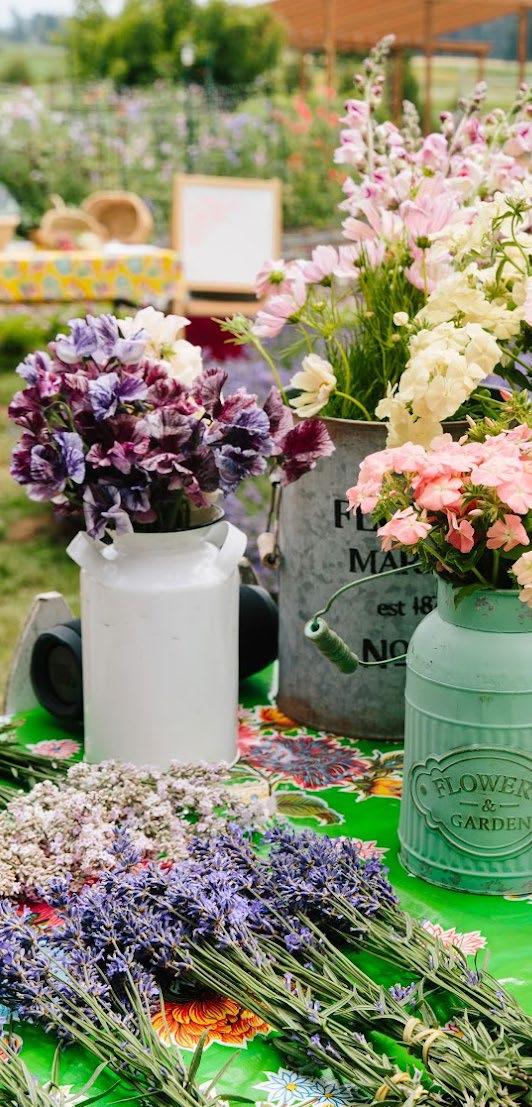
DEBRA PRINZING is the author of 12 books and the founder and producer of SlowFlowers.com, the online directory of American and Canadian flower farms, florists, shops, and studios that supply domestic and local flowers. In 2015, she founded American Flowers Week, which occurs annually in late June. For the past seven years, he has produced the annual Slow Flowers Summit, dubbed the TED Talk for floral professionals. slowflowerssociety.com
ROBIN AVNI is a creative director and experienced designer in the media and high-tech industries. Her specialties include creative management of awardwinning teams and content development. She has produced 18 floral and lifestyle books, including eight in collaboration with Debra Prinzing, showcasing the floral lifestyle of creatives and entrepreneurs. Robin is co-founder of BLOOM Imprint. bloomimprint.com


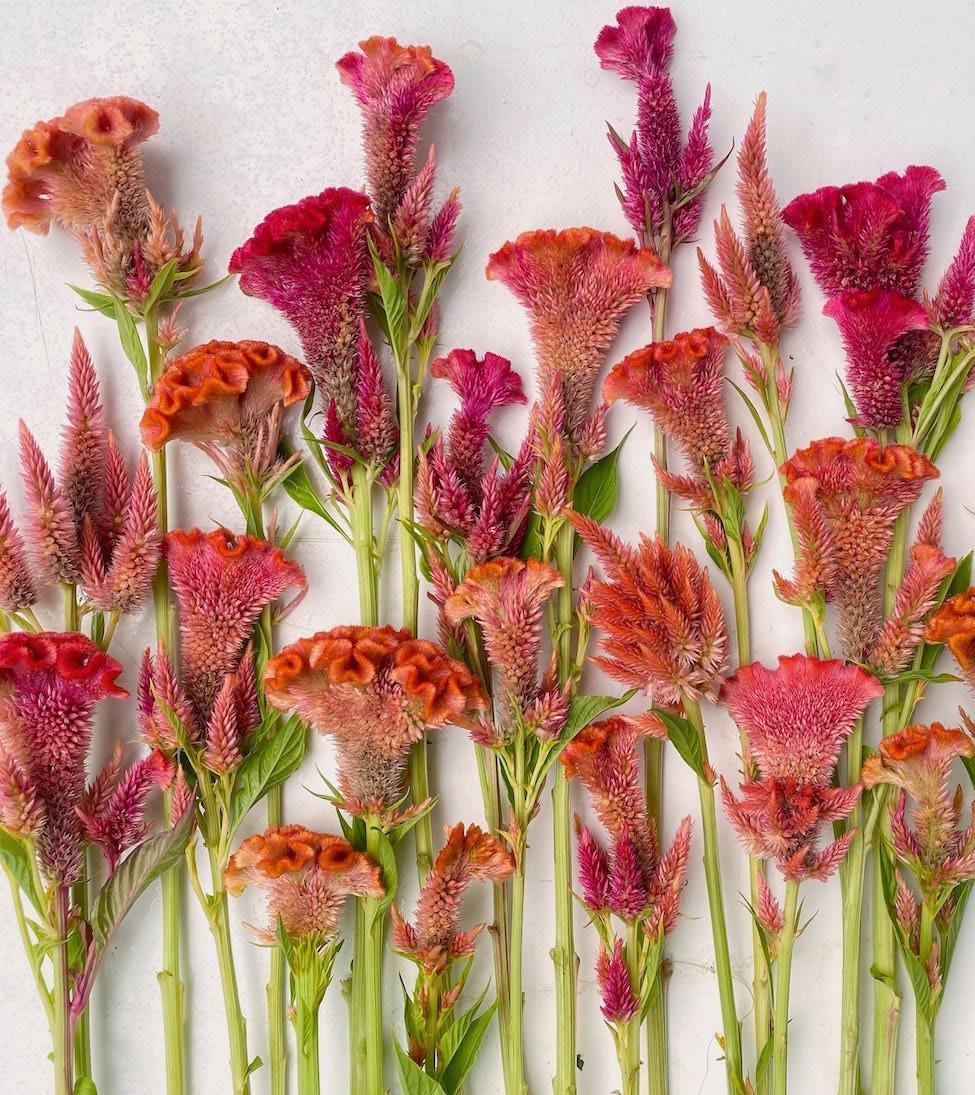
44
35 FROM THE HEART just farming. David and Lina Brunton, Right Field Farm
FLOWER FARMING u-pick flower farming. open your fields to flower lovers
7
SLOW FLOWERS 2025 FLORAL INSIGHTS AND INDUSTRY FORECAST
In our seven insights for 2025, we refine our analysis of a few previously identified topics, tracking the natural arc of change and evolution. We’ve added several other topics that excite us going forward into the New Year. Taken together, they represent the sensory reality of flowers.
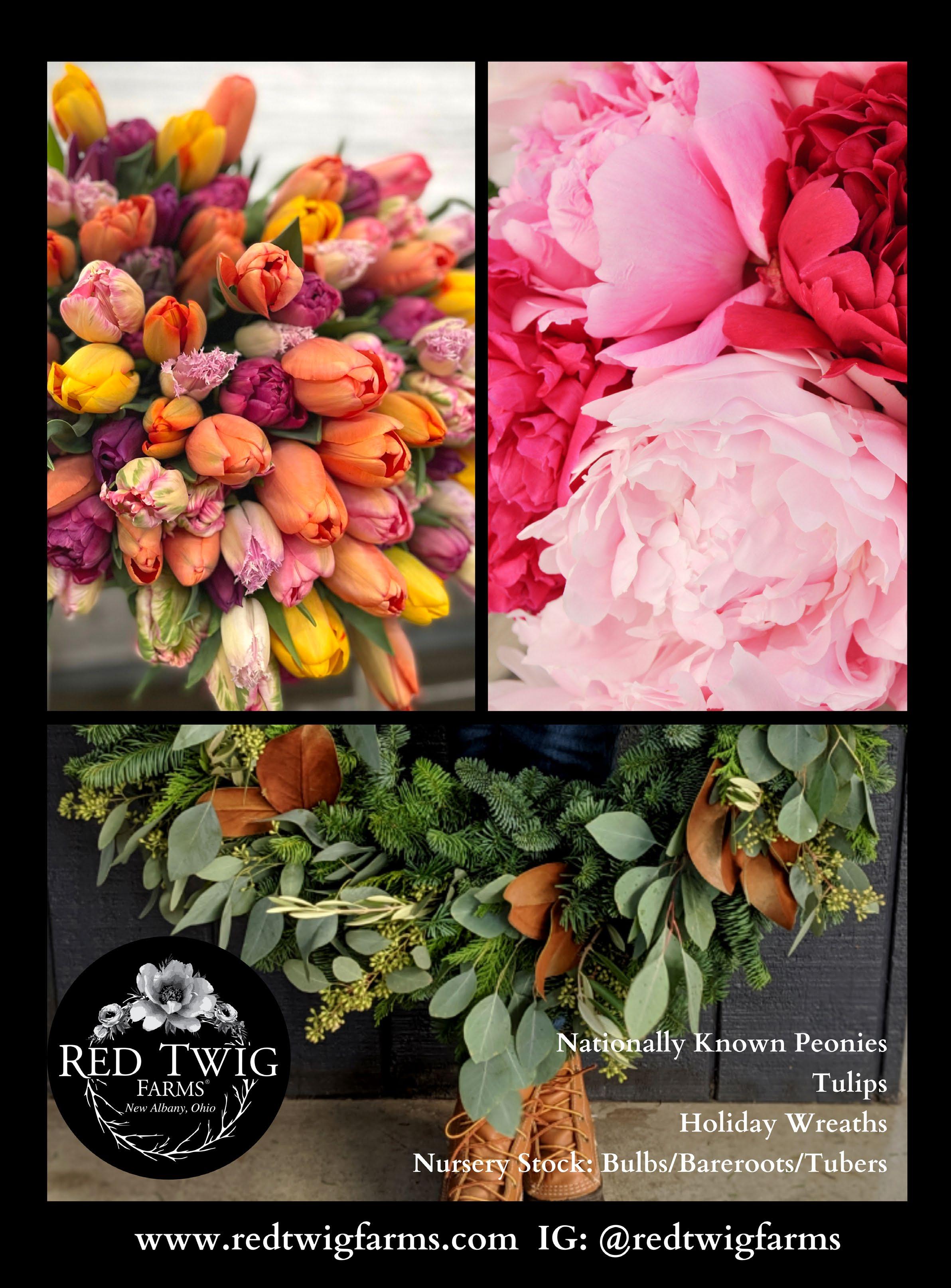
Nature’s perfection cannot be replicated by a chisel, paint brush, or computer
This year, in recognition of Slow Flowers' annual focus on changing cultural and creative shifts in the floral industry, our Forecast hones in on seven key insights. We refine our analysis of a few previously identified topics, tracking the natural arc of change and evolution. We’ve added several other topics that excite us going forward into the New Year. Taken together, they represent the sensory reality of flowers.
We’re not alone in celebrating the magnetic pull of flowers. New York Times Magazine recently devoted its Travel Issue to “Nothing But Flowers,” highlighting the meaning of flowers as an icon of beauty, provider of sustenance, and symbol of divinity and desire around the globe.
While reality may be a little hard to take lately, immersion in nature is not. It is literally grounding. Flowers are a universal language, something understood both viscerally as well as intellectually. The mythical power of a bloom is without cultural barriers.
Flowers are in our DNA and we’ve identified the most exciting links in that chain. In a year where Artificial Intelligence has become omnipresent, we find ourselves reverting to the Analog world of nature. Innovation and personal expression are being challenged by the AI-dominated ecosystem, and the authentic values of the Slow Flowers Community are its antidote. Nature’s perfection cannot be replicated by a chisel, paint brush, or computergenerated image, as all these works draw from the original source. A flower produced from AI is generated from what already exists. However, a flower grown from seed is the perfect metaphor for our individual creativity.
Is the future of your floral creativity contained in a seed? Flower seed purchases have held relatively stable over the past five years, according to the National Gardening Survey, which estimates that 23.4 million U.S. households purchased flower seeds in 2023. We know that home gardeners want to get their hands on the same cut-flower seeds grown by professional flower farmers. And now, beyond saving seeds each season, growers are embracing an age-old practice of flower breeding. New introductions give growers a way to differentiate themselves in the marketplace.
Long before flower breeding took place in laboratories and isolated greenhouses, farmers relied on a low-tech approach, observing unique varieties of food and flower crops through the seasonal growing cycle. Selecting and isolating plants with appealing characteristics — and collecting their seeds to trial the following season — is having an exciting renaissance. While large seed companies have the resources to undertake breeding, it’s inspiring to learn from Slow Flowers members who are doing just the same.
At PepperHarrow Farm in Winterset, Iowa, Jennifer and Adam O’Neal didn’t set out to breed a new celosia variety, but when Adam noticed a “bizarre offshoot” of a single celosia plant, he decided to save the seed for future evaluation. “We separated out those seedlings from everything else, and the next year, it made the same color again,” he explained. The couple named the celosia ‘Chester Copperpot’ for its beautiful, rusty-burnt-orange characteristics.
The flowers were originally grown from a packet of Baker Creek Seeds' open-pollinated heirloom celosia seeds. Coaxing an entirely new palette required the O’Neals to plant the seeds they saved in a remote area of their farm. Adam estimates spending five or six years to ensure the variety remained consistent and prolific. “This ‘Chester Copperpot’ color has never existed before and it’s not
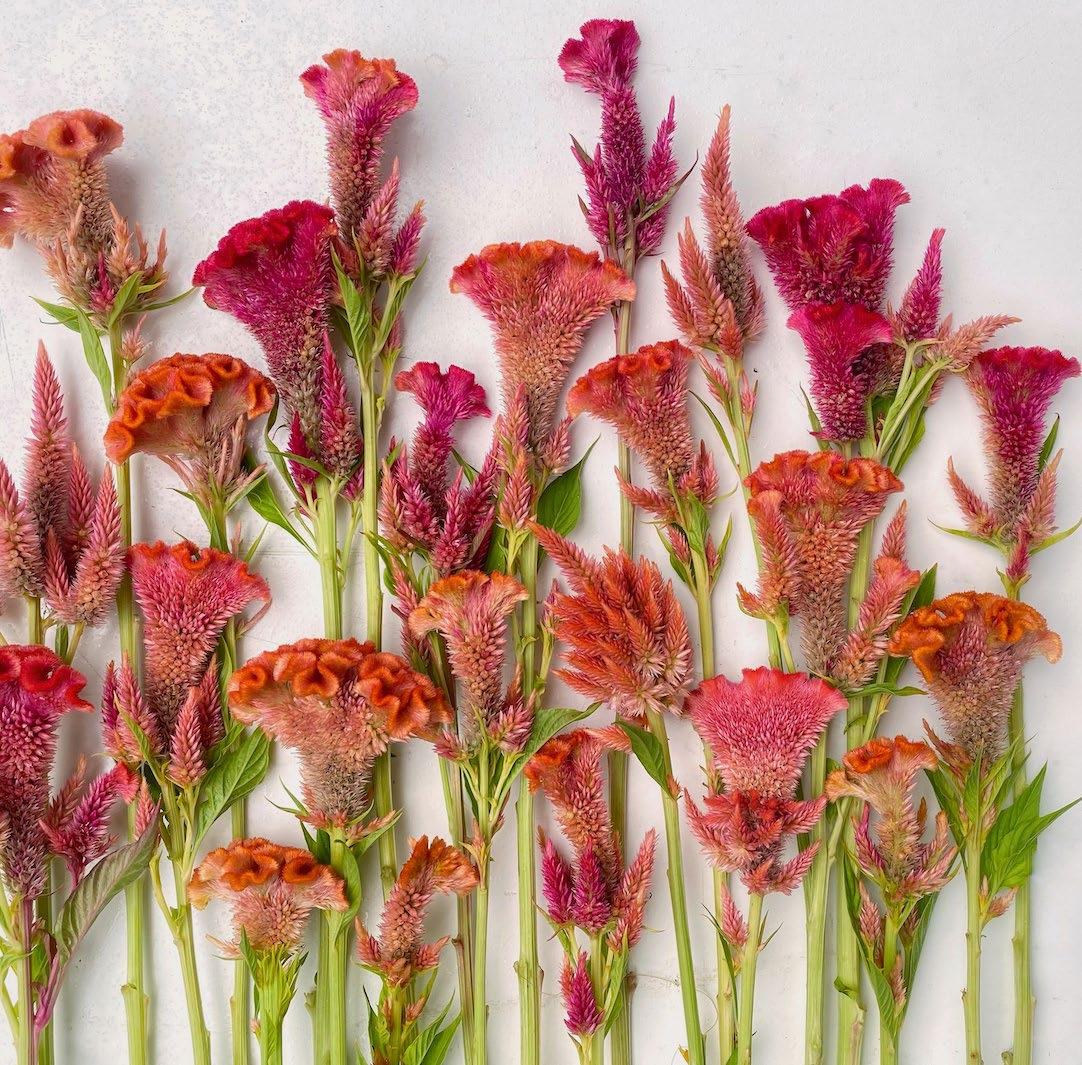
commercially available anywhere,” he noted. To protect future production of its seed from crosspollination, it was important to continue planting in a separate growing zone. “Or, you have to net it so that pollinators can’t get into those flowers and cross your colors.”
After building up the stock of ‘Chester Copperpot’ as a seed mix, PepperHarrow Farm now releases a limited quantity of 25-seed packets each season. “It ticked all the boxes as a good seed producer," Jennifer said. "The color was great; the shape looked really pretty; and it produced a ton of seeds.” They decided to sell it as a mix, she explained. “Not every single flower will bloom exactly like ‘Chester Copperpot.’ It isn’t because it’s unstable, but because, inadvertently, a pollinator has gotten in there and brought in another color that we didn’t want, for example: producing a gold or red bloom. We love a little color variation in the ‘Chester Copperpot’ seed mix and other flower growers and gardeners have loved it, too.”
Other unique celosia colors have emerged, allowing for additional breeding efforts. “We noticed a mix of hot pink and orange blooms on the same plant, so we started separating it out,” she said. “It’s crazy; it’s abnormal. It’s nothing we’d ever seen.” They named the extraordinary colored, orange-pink celosia ‘Rainbow Sherbert‘ and they hope to introduce a new pink celosia, tentatively named ‘Pink Lemonade‘, in 2026.
Jennifer and Adam admit that sales of ‘Chester Copperpot‘ seed packets will never make them rich, but they are nonetheless excited about their unique seeds. “This breeding program keeps us interested in our day-to-day activities,” Jennifer said. “It inspires us as people who grow flowers every day. We’re keeping our seed collection very ‘boutique.’ We don’t have to be huge, but we’re passionate about sharing our special seeds out into the world for others to grow in their gardens.”
Tap into the wonderment of seed breeding by closely observing your garden or flower farm’s ecosystem. For Katie Tolson, owner of Seed-onHudson, based in Hastings-onHudson, New York, the magic of discovering (and nurturing) a naturally occurring annual has sparked her newfound interest in breeding.
“There’s a new cultivar of Nicotiana (flowering tobacco) that cross-pollinated in my field in 2023 and self-sowed/ overwintered to again grow and bloom in the 2024 season. It's the same shape as grandiflora and just as fragrant. The facing flower’s center is pure white, but what’s different is the watercolor 'wash' effect in blush-mauve tones that shimmer on the reverse side of each petal.”
She’s excited to pursue this discovery further. “I’ve kept seeds and I’ll grow some this coming season to see if it actually comes back with the same features.”
Katie has learned that breeding can be accessible to small-scale growers and home gardeners. For example, some growers use organza bags over blooms to protect an unusual flower from cross-pollination, she explained.
The time devoted to observation and documentation may or may not pay off, but the experience keeps Katie closer to her passion of growing flowers. "It’s thrilling to put the time, heart and commitment into stewarding a new variety with the potential of maybe someday sharing it with our wider community of growers and giving those seeds life beyond just your garden or farm."

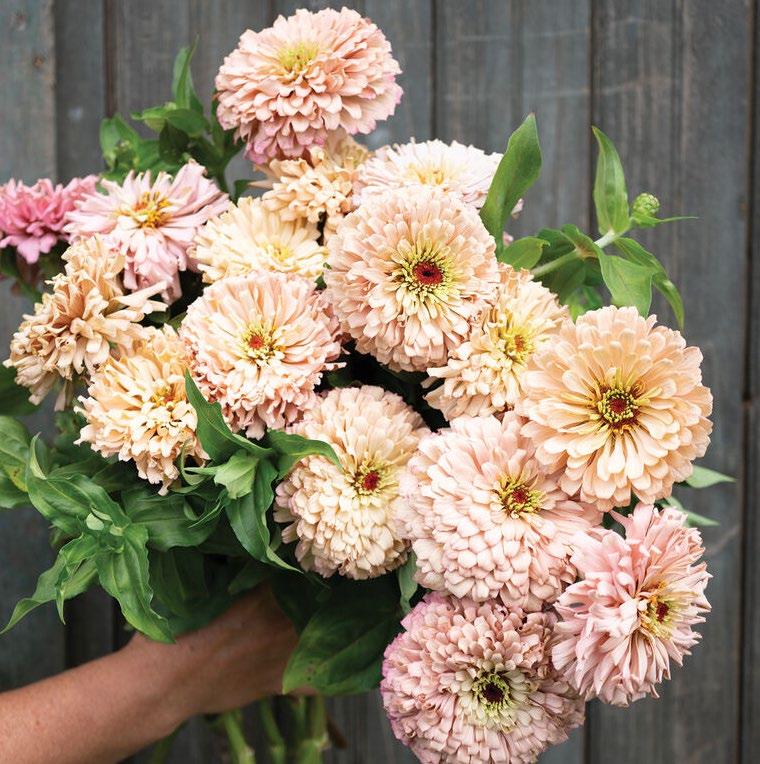

According to Hillary Alger, the demand for seeds of superior cutting garden annuals started to rise 10 years ago because of the increased interest in flower farming and DIY floral design. “Gardeners are seeing all the beautiful things they can do with cut flowers,” she observed.
On the December 2024 Slow Flower's Member Meet-up Hillary and Joy Longfellow, of Johnny's Selected Seeds, unveiled many of the 40-plus new flower seeds featured in the 2025 catalog. Of special interest was the company’s first-ever exclusive flower seed introductions which included three zinnia varieties (‘Ballerina‘ , ‘Agave‘, and ‘Aurora‘) and one celosia variety (‘Shimmer‘).
Senior Plant Breeder Lindsay Wyatt explained that while Johnny’s first began breeding flower seeds in 2016, it takes years to select and then produce the seed quantities needed before they are ready to release to the public.
Linsday used ‘Ballerina‘, a pastel pink blend of large double-blooming zinnias, to illustrate their breeding process called ‘Recurrent Selection‘. “We only have ‘Ballerina’ plants in (a specific growing) area, so that there's no cross-pollination between that and other zinnia colors, because these are all insect-pollinated.”
From that area they select their favorite plants and save seeds, going through the field about six times through the growing season. "It's a lot of work, but a lot of fun just being out there with the flowers,” she said.
“We spent a lot of time really looking at nuanced shades and exactly which shades of pink we want. We look a lot at flower structure and the doubleness and plant height and the healthiness of the plants. Once we know what we want, then we know what we don't want. So we remove the plants that we don't want, which can be upwards of 90% of them.”
“We cut back everything that's remaining. We usually do that in July, so that we can have a fresh start for all pollination to happen. Then, we let new flowers open and they’re insect-pollinated, again, just within that isolation and just within our selected plants.” ”
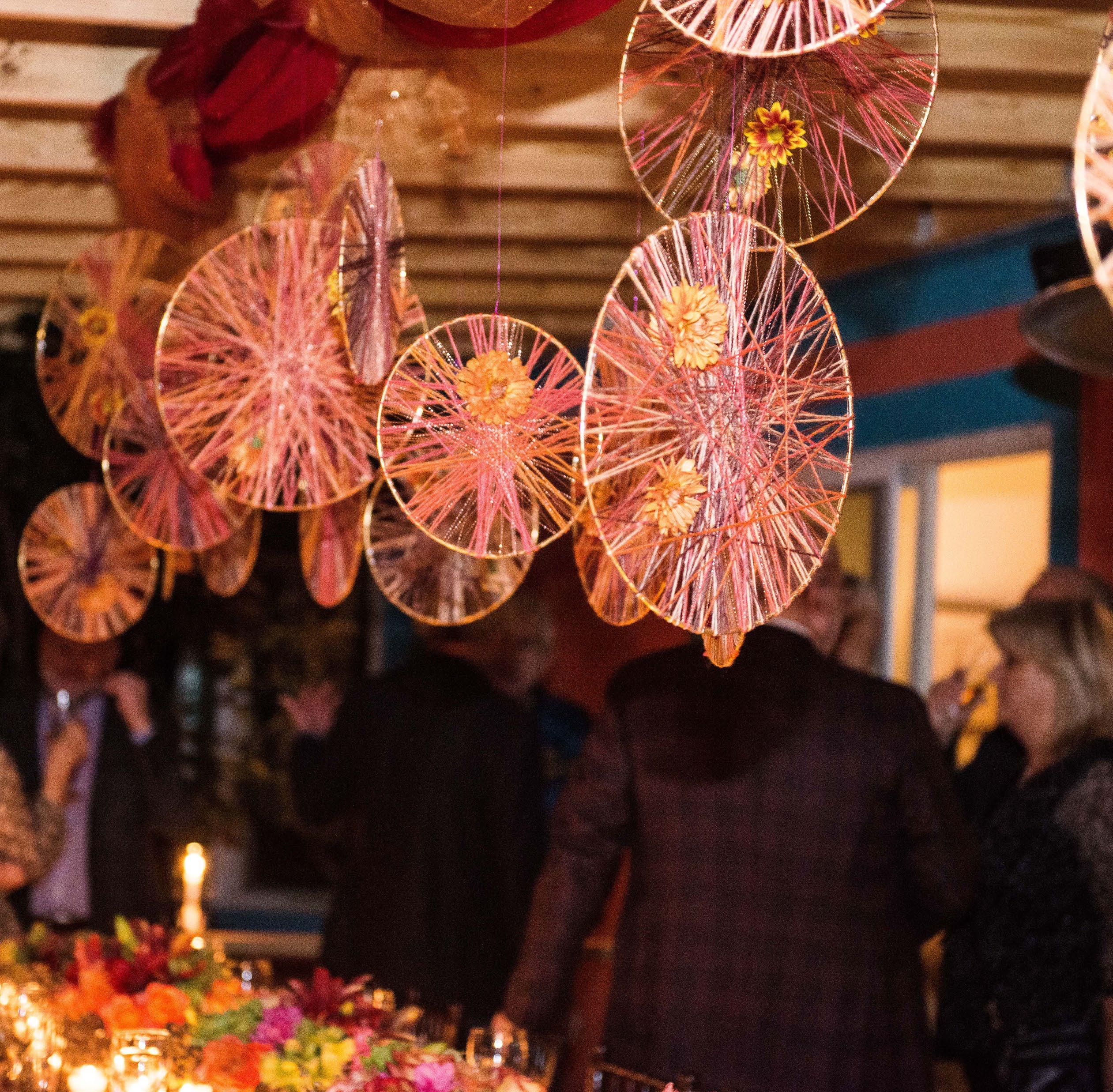
After nearly a decade of R&D devoted to alternatives to floral foam, many with mixed results of success and others not widely available or affordable, we’re fascinated with another way to design without foam. At the 2024 Slow Flowers Summit in Banff, Alberta, Canada, attendees learned about floral design that exposes sculptural armatures and exposed mechanics from Hitomi Gilliam, AIFD, one of the most creative advocates for designing without foam. Essentially, she highlights (rather than hides) the mechanics.
At first glance, building an armature out of natural materials or branches may feel time-consuming or costly. But Hitomi argued it is a sustainable and economical approach that’s right for today. “I love designing with flowers and I also love the art of structure building,” she explained. “We start with the ‘skeleton’ or the ‘silhouette’ of the design. Once that’s established, it’s pretty easy to design into that framework because you’ve already figured out where things will go.”
Her distinct aesthetic uses natural materials like branches and fiber, as well as reusable materials such as metal wire, mesh, or wood. Single-used plastics are skipped, and glass water tubes and other attachments are secured with compostable jute or twine, reusable wire, yarn, and natural fiber – all of which is visible in the final design.
Against the backdrop of making floristry both affordable and sustainable, Hitomi’s approach is timely. “I really feel like the cost of flowers and the generally higher cost of supplies give us a reason to design more minimalistic with flowers. It’s really about an economy of means.”
Choosing materials that are not single-use and or destined for landfills is important. “The whole sustainable concept makes sense in that you can actually save money and materials in the end,” she added. “You can re-use these structures over and over again.”
Many foam-free mechanics aren’t visible, especially when designing for wedding bouquets, Hitomi noted. “If there are budget constraints, it’s useful to use a chicken wire ‘pillow’ to arrange in. This type of mechanic allows me to pare away one-third of the floral material that would otherwise go into a full hand-tied bouquet. So I can save money and still have a larger piece.”
Whether you use a chicken wire mechanic or the Holly Chapple “pillow” or “egg” mechanic, Hitomi suggests that you instruct the client to return it for some kind of compensation or refund.
“The more that people understand about return policies, it will become a habit. It’s just like paying a deposit on glass bottles. That was a new concept way back when! Now, we need to encourage floral consumers to be more conscious and return items for a refund.”
Let’s face it, the marketing world’s secret motto could easily be: “just add flowers,” as a proliferation of brands are employing flowers and plants across consumer and B2B platforms alike. In 2025, houseplants, armloads of flowers, and botanical installations will continue to appear in our feeds, used to promote everything from financial services to fashion. Brand activations and corporate collaborations have appeal, but it’s imperative to stay authentic to one’s own mission and values when choosing partners.
It can be flattering to be asked to provide flowers for a business or brand partnership. But you should do your homework before saying yes, Christina advises. “Companies often see these partnerships as a cheap way to acquire new customers – your customers.”
Do not work for free or for “brand awareness” alone. “It has to make financial sense for you,” she said.
A partnership should not cost you more than the company or brand spends. “Installations and activations can require a lot of flowers. If (the partner) wants flowers for a pretty picture, then they can pay you as a floral vendor. That is a business relationship, not a partnership.”
Calculate the ROI. Sharing revenue for your product sales may not make sense, but donating a limited number of bouquets or in-kind blooms may be worth it if you can reach specific influencers and raise awareness for your brand.
Flower farms and florists offer tangible and intangible advantages to a marketplace hungry for the positive vibes of blooms – the examples abound, thanks to the universal excitement of flowers as a branding icon.
The Slow Flowers community knows this to be true, exemplified in corporate partnerships recently profiled in the Slow Flowers Journal – including members who have teamed with Jo Malone London, The Tie Bar, and the reality television show, ‘The Bachelorette’. Local flowers elevate special events, venues, and installations, and clearly, consumer brands want to tap the expertise of growers and designers to enhance their marketing campaigns.
Christina Stembel, founder and CEO of Farmgirl Flowers, is no stranger to corporate co-branding opportunities, estimating that she has fielded more than 200 such requests since forming her business in 2010. “We’ve probably only said ‘yes’ 20 times,” she admited. For example, Farmgirl has collaborated with Levi Strauss, Pendleton, and L.L. Bean, each of which provided their recognizable textiles for Farmgirl Flowers to swap out its original burlap wraps for co-branded bouquets.
We often see flowers added to branding campaigns, but marketers don’t necessarily appreciate the true costs of those blooms. “Everybody wants a viral photo, like showing a 10-story building in the middle of Manhattan covered in flowers,” she noted. “They want it for a picture, but they don’t want to pay for it.”
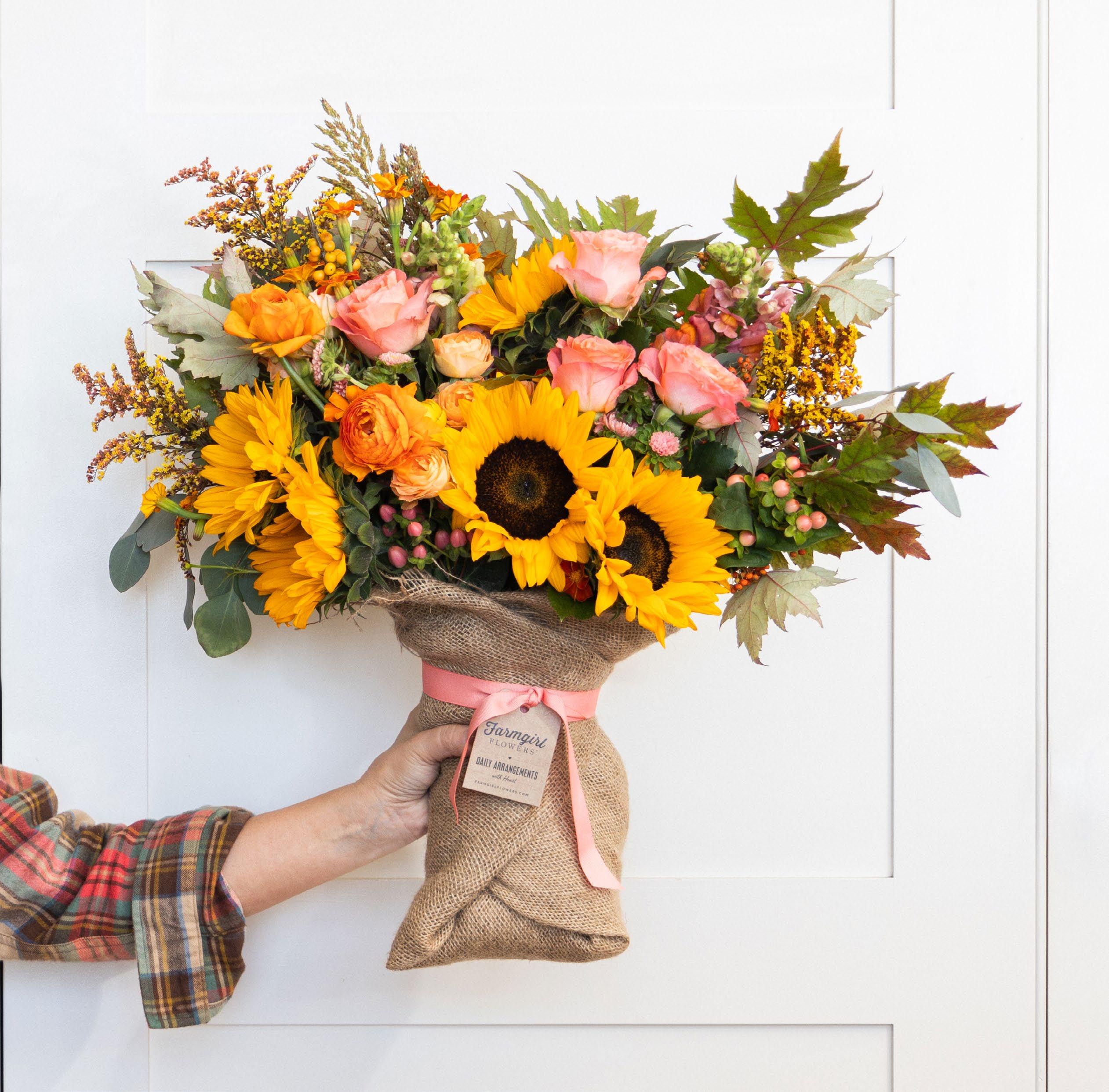
After 14 years in business, Farmgirl Flowers recently said yes to what CEO Christina Stembel describes as a “dream floral activation” with pop star Gwen Stefani. Farmgirl Flowers supported the launch of the artist’s new album, titled “Bouquet,” adding a custom Farmgirl Flowers x Gwen Stefani bouquet (previous page) to its product offerings in November, which quickly sold out. “Every bouquet we sold had some collateral about her album inside the box,” she said.
The collaboration originally came to Farmgirl Flowers through Gwen’s record label, and Christina praises her team for making it a success. It worked because Christina was clear about what Farmgirl would and would not be able to provide. Most importantly, revenue-sharing was off the table. “The margins for flowers are razor thin; we can’t work this hard to not make

a profit,” she explained. Farmgirl Flowers made investments of in-kind flowers, plus staff travel and time, but those costs were worth it, Christina said. “I realized why Gwen Stefani wanted to do this collaboration with us. It’s because she genuinely loves flowers. This wasn’t like other corporate partnerships where all they want is our customer list. Gwen really, really loves flowers. There was so much joy for us to see her face when she walked into the space we had designed and filled with flowers. It was definitely emotional. Everything in her album is about what flowers mean
to her and who she is. I’m so grateful that we got to do this campaign with her because it was authentic.”
Christina and Gwen appeared together on The Today Show, they shot a promotional video together, and shared social media content. Farmgirl agreed to send gift bouquets to 50 influencers (with “From Farmgirl Flowers and Gwen Stefani” on the tags).
Christina also delivered bouquets to the set of The Voice, for Gwen to share with fellow judges. “Of course, we loved getting our flowers into the hands of Snoop Dogg, Reba McEntire, and Michael Bublé,” Christina says.
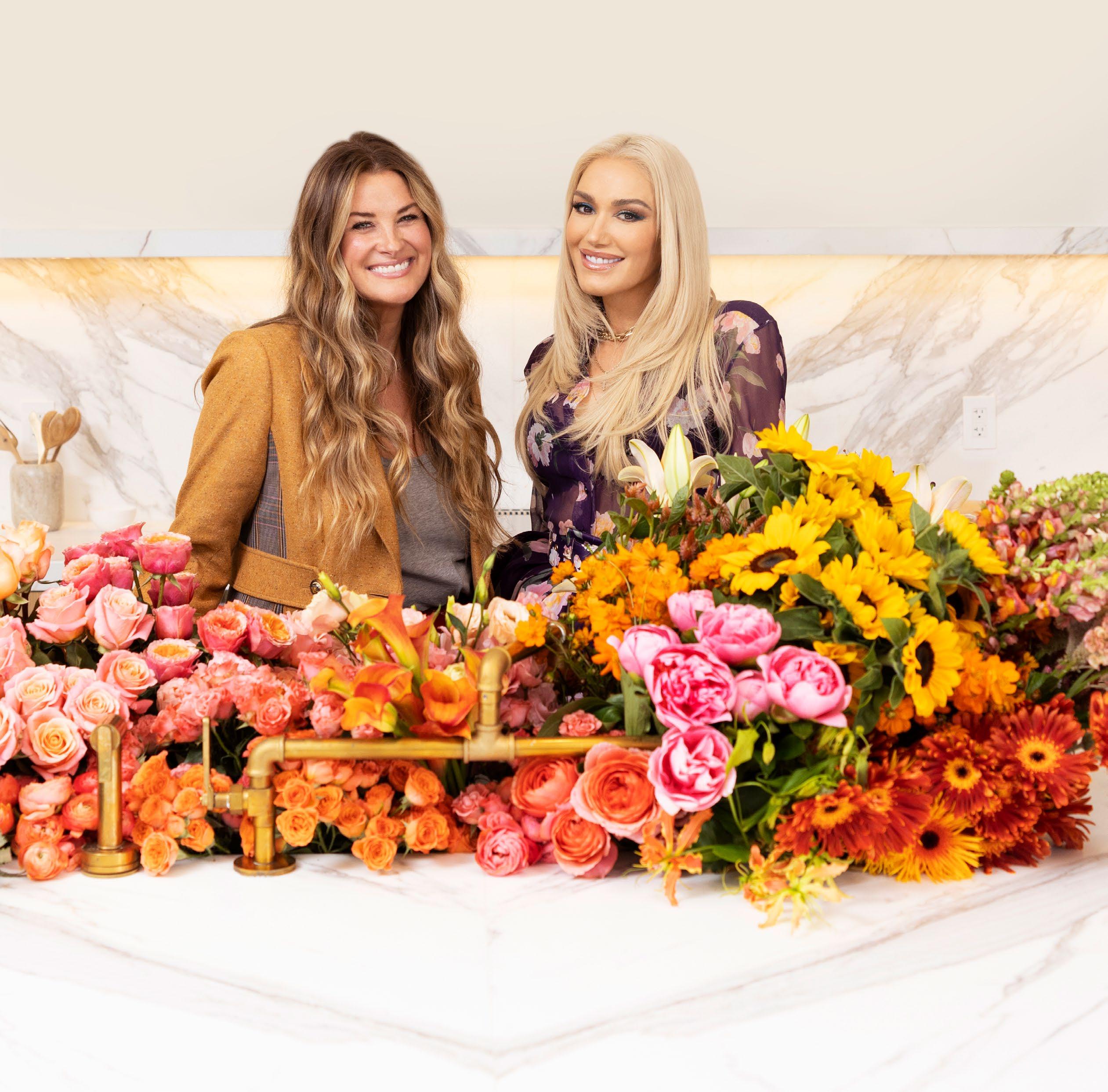

Katie Lila is the producer and host of “Follow the Blooms,” a digital series that launched online in 2023 and is set to debut on KSPS (Spokane Public Television) this coming spring. Through Flowers for People, her Spokane, Washington-based studio, Katie blends floral installations with filmmaking to help organizations and brands to reach new customers and build community.
We’ve covered the many ways that Slow Flowers members are helping boost floral awareness, including our 2024 insight called “Floral Literacy.” For Katie, high fashion is the best analogy for moving flowers into the mainstream. “You look at how amazing runway shows push creativity, right?” she asked. “We’re not necessarily wearing those looks, but the fashion show inspires new colors and new ideas, and the whole industry responds.”
She’d love to see this model replicated with flowers. Building on the success of “Follow the Blooms,” Katie formed her studio’s creative services effort to encourage brands and companies to add floral experiences to their events. “We need to place flowers where customers already are,” she maintains. “Nobody can be sad if we add flowers to a NASCAR race or a Taylor Swift concert, right?”
Videos have an exponential reach, Katie says. “We need to see more than a ‘blip’ on Instagram. Is it successful if you have flowers at a trade show or an event opening, but only the people who attend get to see it?” She believes that filmmaking elevates the impact of a floral activation. Recently, Sustainabloom.com, the American Floral Endowment (AFE) industry initiative, tapped Katie’s studio to use video storytelling for its 2025 awareness campaign. The result is a soon-to-be unveiled video called “Sustainabloom Road,” at the heart of which is a dashed yellow line made of flowers, marking the center of a roadway. Katie originally envisioned the 90-second film as the story of a “yellow bloom road,” with people adding

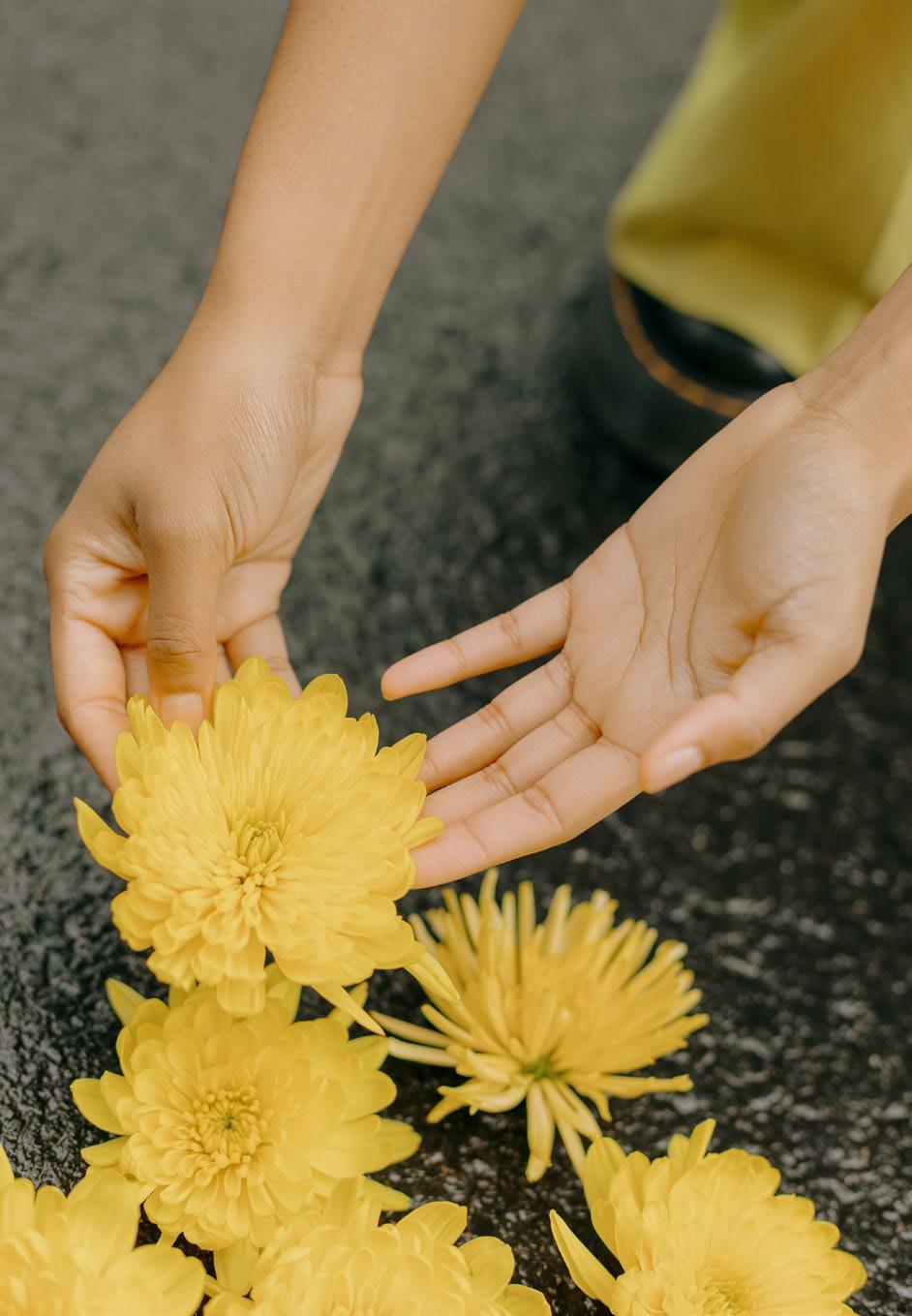


flowers, riding bikes, and joining the journey together. She pitched the concept to AFE, as “everybody along the flower chain, on the same road, coming together to make the floral industry better.”
According to AFE’s executive director Debi Chedester, “the purpose of the video is to help promote our sustainable brand and to let people know more about it.” With short videos dominating social media, she also wants to use the film and smaller video clips in presentations, at trade shows and conferences, and to introduce Sustainabloom.com’s resources. “We love the combination of imagery, words, and voiceover, plus a peek at our website – and it’s also and it’s also mobile-friendly.”
Katie originally explored many of the ideas she’s now selling to corporate partners while creating her television show. She’s motivated to make flowers a national obsession and is focused on landing more blooms at public and private events, and inviting attendees to have a sensory experience with flowers. Floral activations can include:
“Our experimental fresh flower installations deliver a magnetic, multi-sensory experience that make event attendees feel like they’ve stepped into a world where pure imagination becomes a reality,” Katie said. “It’s not just a pretty photo op; rather, these vibrant displays can transform brand messaging into a living narrative that sparks connection and inspires wonder.”
“Our flower experiences and flower LIVES transform an everyday event into an entirely interactive, hands on floralventure. We want to turn concerts, sporting events, or community gatherings into happenings where fresh flowers come ALIVE in totally unexpected ways.”
More than just adding flowers to a venue, Katie said, the experience might include fab floral wearables making a statement or an explosion of blooms in the crowd. “It’s about experiencing joy in vibrant settings that blurs the lines between nature and culture, all while creating a sense of togetherness and shared excitement.”
Breathtaking beauty is discovered in the winter, a time when flower farmers and floral designers are likely to find limited supplies of locally grown botanicals. From the Winter Solstice to Spring’s Equinox, there are 13 weeks during which our gardens, farms, and much of nature sleeps. As a result, floral designers whose work is steeped in seasonality find their creativity stretched. Thankfully, growers are experimenting with cold-weather crops, cheating the season with high tunnels and other bloom-forcing techniques.

FLOWER FARMERS
Inspiration & Advice from Expert Growers by Debra Prinzing and Robin Avni
Cover Photo by Mary Grace Long
Photography
Abrams Press, 2025; 272 pages
PRE-ORDER HERE
Excerpted from The Flower Farmers, Abrams Books
Thanks to a quirk of history, Valentine’s Day takes place on February 14th, and thus, the biggest floral holiday of the year coincides with the mostly dormant winter season. Longtime hellebore growers at Jello Mold Farm in Mt. Vernon, Washington, Diane Szukovathy and Dennis Westphall knew their winter perennial flowers were popular with local customers of the Seattle Wholesale Growers Market, which they helped to co-found in 2011. But the timing for harvesting blooms from field-grown Helleborus orientalis for Valentine’s Day was off. Their hellebore crops typically bloomed in March and early April.
Dennis and Diane’s research led them to trial newer hellebore hybrids, including Ice N’ Roses ‘Red‘ and FrostKiss ‘Cheryl’s Shine‘. “These plants were originally hybridized for the European market, because Europeans use hellebores similarly to how we use poinsettias as a holiday plant in the U.S.,” Diane explained. The hybrid perennials produce large flowers that face outward, supported by long, upright stems – just what florists want. “We dedicated two hoop houses to hellebores and planted hundreds of plugs,” she said. “By the following year, we took a truckload of hellebore bunches into the Market for Valentine’s Day.”
In a marketplace with customers who care about sourcing locally grown flowers, most florists have struggled to meet requests from customers who want alternatives to the standard Valentine’s Day fare. So the Jello Mold hellebores fill an important – and beautiful – seasonal role.


Brooke Palmer shared how and why she embraces winter tulip production on the Slow Flowers Podcast Episode 691: The Case for Growing Winter Tulips. Her farm, Jenny Creek Flowers, is based in Trumansburg, New York. Seen through her Slow Flowers sustainability ethos, Brooke has considered the benefits of forcing thousands of tulips into bloom during the off-season. She values this winter crop because it supports customer demand for locally grown blooms and financially sustains her floral enterprise during the time of year when outside temperatures dip to the low teens.
“I have a 10-week winter tulip CSA that's my premier offering of the year. And that's the one that I more than doubled my shares this year and it sold out in under a week, which is really exciting. Once people get the taste of these flowers, they really want them in their lives.”

From her farm Willamette Willows, based outside Eugene, Oregon, Alana Karam shares that willow is a great investment for flower farmers. Why? Because it provides florists with a local option in late fall and winter, when other botanicals can be scarce, and when so many florists are tempted to order non-local options. As Alana said, “curly willows provide reds, oranges, and yellows. And pussy willow in early spring is so sentimental for so many people.”
Willamette Willows grows more than 40 varieties of Salix, with a focus on the three distinct categories of willow plants and their markets – including cultivars suitable for basketry and woven garden structures, as well as the many varieties of curly willow and pussy willow loved by floral designers. Her story makes us wonder: Why aren’t more flower farmers getting into the willow market?
SF Podcast Episode 693: The Wonderful World of Willows with Alana Karam of Willamette Willows

Lori Poliski of Woodinville, Washington-based Flori has a fondness for designing with evergreens and conifers. “I absolutely love conifers. I love their fragrance. I love the lacy quality of some of the cedars. I don’t know why they’re not more popular,” Lori asked, “Conifers have been pigeonholed for just the holidays because they are abundant. But they are abundant all year long and they provide every shade of green to a design. Plus, one of their benefits is having a really long vase life in water.”
A gardener-florist, Lori harvests many of the conifer and evergreen plants from her own property and she’s begun to plant unique confer varieties for golden and silvery-blue needles.
“Last January, I designed an all-green woodland bridal bouquet with maidenhair fern, sword fern, Cleopatra fern, cedar, fir, salal, huckleberry, lichen, camellia, and a few hellebores. It was for a couple who definitely were forest people,” she says. “But why save conifers just for winter and holidays in November and December? You can just as easily add conifers to spring and summer flowers –like mixing conifers with dahlias.”

Harvest Helleborus orientalis stems once the first and second flowers bloom completely and drop the stamens, so that seed pods have begun to form in the flowers’ centers. If you harvest any earlier, the cut flowers may droop quickly.
Hybrid hellebore blooms (Ice N’ Roses and FrostKiss Series) can be harvested once the second flower has started to open.
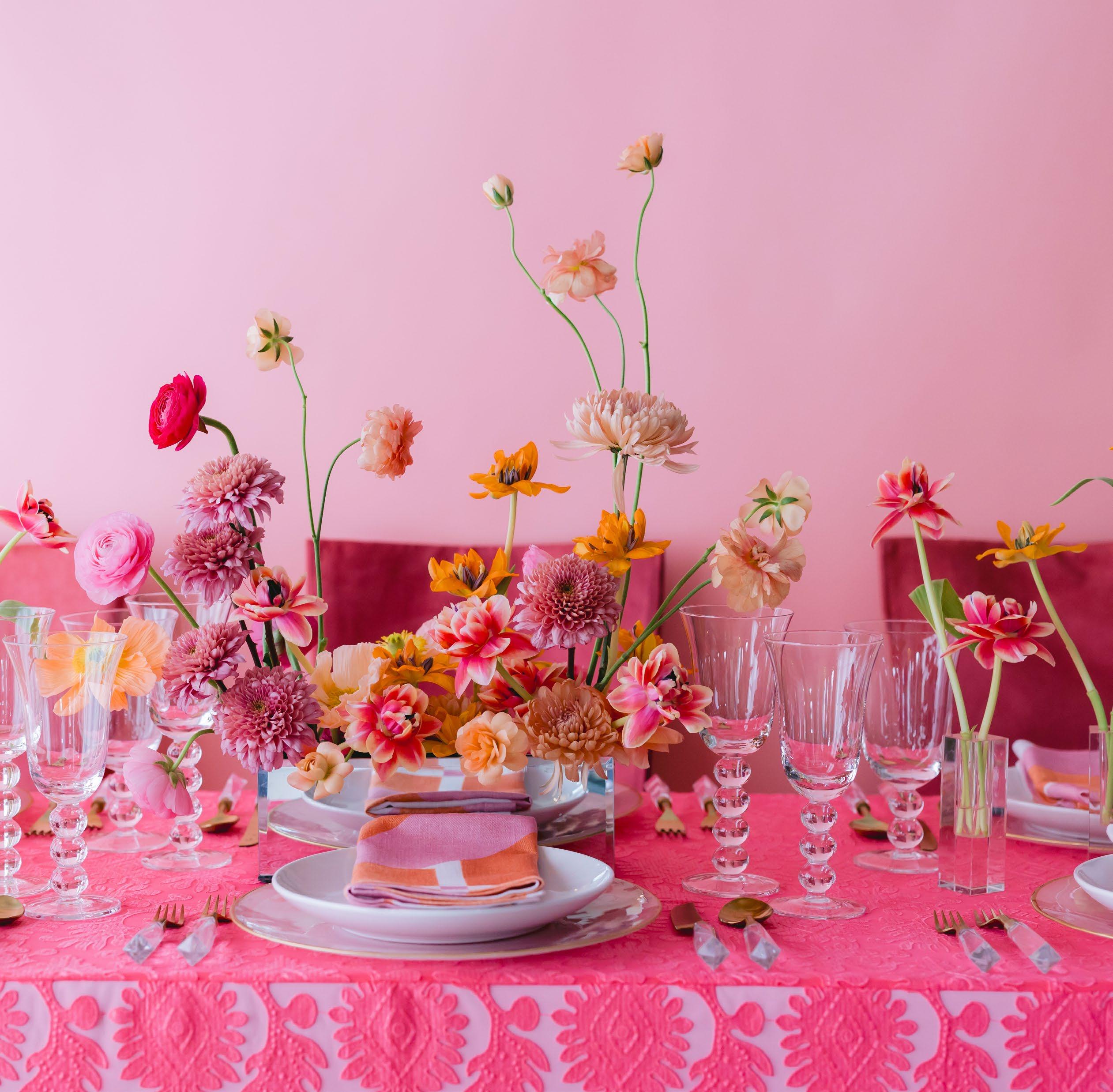
We love the aesthetic of “satellite” florals, which, according to Paulina Nieliwocki of Blue Jasmine Floral, based in Berkeley Heights, New Jersey, are, “smaller elements that echo the central design.” Like a series of planets orbiting around the sun, a constellation of bud vases, pin frogs holding single stems, mini-ikebana arrangements, or foraged gifts from nature can together compose a full tabletop installation.
Some call this concept “anti-inflation design,” as less adds up to more. When multiple forms and finishes are repeated across the surface of a table or mantel, their scale and presence feels luxurious (at left). With common elements throughout, the look is harmonious.
“I love to use satellite pieces for head tables because they look so special,” Paulina explained. “They also work for long tables.”
Toronto-based designer Cynthia Zamaria brought her styling techniques to the 2024 Slow Flowers Summit, where she demonstrated a cohesive tabletop using minimal flowers with vintage porcelain urns and pitchers used as bud vases. The design narrative included layers of striped, checked and floral-patterned linens, and levels of candlesticks and taller vases. Shopping for vintage pieces has long been Cynthia’s approach to home décor and floral styling. In her book House + Flower (BLOOM Imprint, 2022), she wrote of floral and vase pairings:
“One of the more dramatic yet simple ways to display blooms is to keep your arrangements limited to one variety. . . . Stay on the lookout for interesting vases in a range of shapes that will best suit the flower’s stem, foliage, and bloom shape.”
Cynthia's enthusiasm for timeless tabletop items – found at thrift stores, yard sales, or online – is aligned with her sustainable values of embracing the second-hand economy.
Unity and variety. Unifying features tie a composition together; a variety of similar pieces adds interest.
Singular sensation. Showcase an herb stem, a flowering branch, or a single bloom in a dramatic presentation of “less is more.”
Love your leftovers. Make the most of short stems or oddball pieces and give them a new purpose in a grouping of bud vases.
Repurpose with a purpose.
As Cynthia Zamaria says, “if it holds water, it’s a vase.”
We love this philosophy and it might just change the way you view a juice bottle, vintage apothecary jar, or a simple salt shaker (minus its long-lost cap).
Wondering what's NEXT in your portfolio of floral products and services? In last year’s forecast, we noted flower pressing as part of an Insight called “Floral Literacy.” For 2025, we expect more flower farmers and florists will embrace the revival of oldfashioned pressed flowers, also called preserved flowers. The techniques may vary, but there’s enduring sentiment when a petal, leaf, or bloom is captured as two-dimensional art, long after its three-dimensional life in a garden or vase.

SLOW FLOWERS EPISODE 692V
Watch the replay episode HERE.
Our thinking has been influenced by several Slow Flowers members who are integrating flower pressing as a new product or service. Customers of their shops, studios, and flower farms are responding enthusiastically. In November, we hosted Kate Punnett, owner of The August Press in Ottawa, Ontario, Canada, as our expert presenter during the Slow Flowers Member Meet-Up. Kate calls herself The Pressed Florist, and she has embraced the timeless art of pressing flowers in her fine art prints, greeting cards, and other commissions. She also sells custom-made flower presses and teaches others.
The session touched on many of the questions people have about the process, and Kate demonstrated her approach, sharing especially useful tips on pressing and drying flowers with thick elements like a rose or the center of a sunflower. “If you already have a floral business, whether you're a farmer or florist, think about adding pressing for the winter when you're not growing, or something to offer year-round for brides who have already purchased florals from you,” she suggests.
“Just like gardening and just like creating bouquets and arrangements, there's so much memory that happens in your hands and in your head and in your heart during the pressing process. What we're doing is taking something fresh and transforming it. It’s not just about squeezing the moisture out of a bloom and letting it dry. It's actually about keeping the essence and the aliveness of what it used to be and transforming it into something else.”


Sarah Berquist’s Stockbridge Floral Design students at UMass Amherst recently began working to work with pressed flowers. Like the dried floral curriculum Sarah has developed, learning flower pressing allows students to explore value-added products and sustainable design methods, while also having hands-on opportunities in the winter months. Inspired by pressed florals created by Allie Virzi, the Retail Floral Design course’s teaching assistant, students composed scenes on wood rounds as holiday ornaments. They used pressed heirloom mums, dill flowers, scabiosa flowers, yarrow leaves, raspberry and blueberry foliage, and other botanical elements.
“These ornaments are a perfect item for the Stockbridge Floral Design program to add to their line of products for campus holiday markets, where students also sell dried floral bouquets and wreaths to the campus community,” Sarah explained.
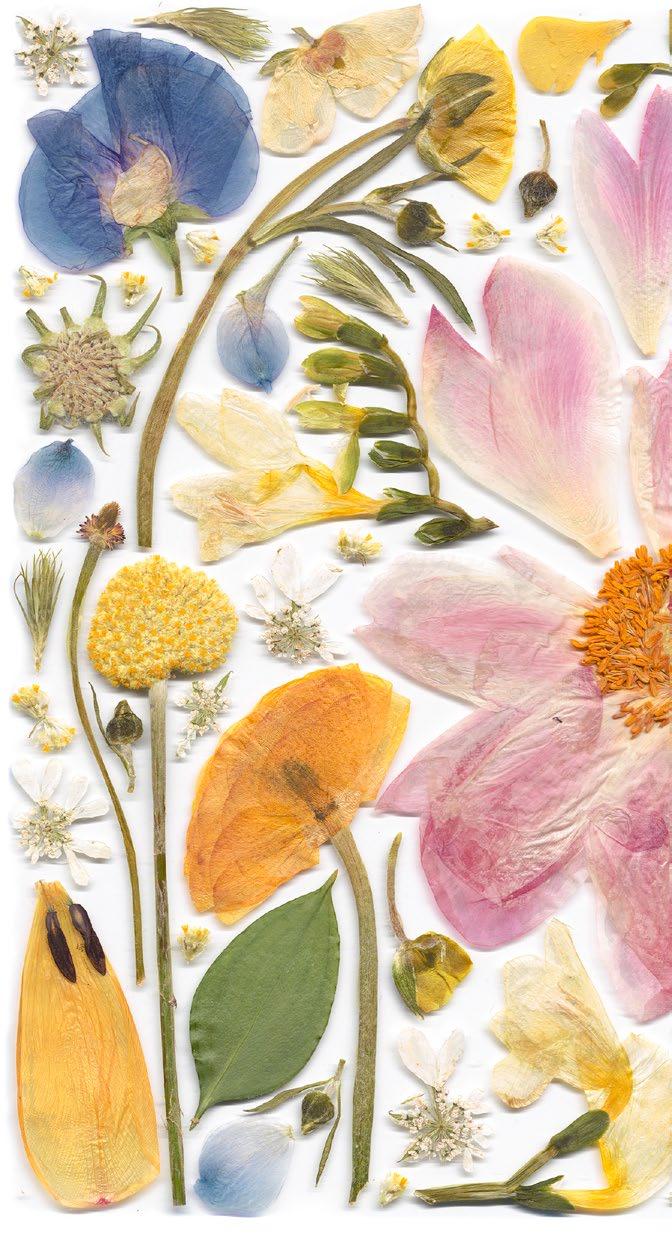

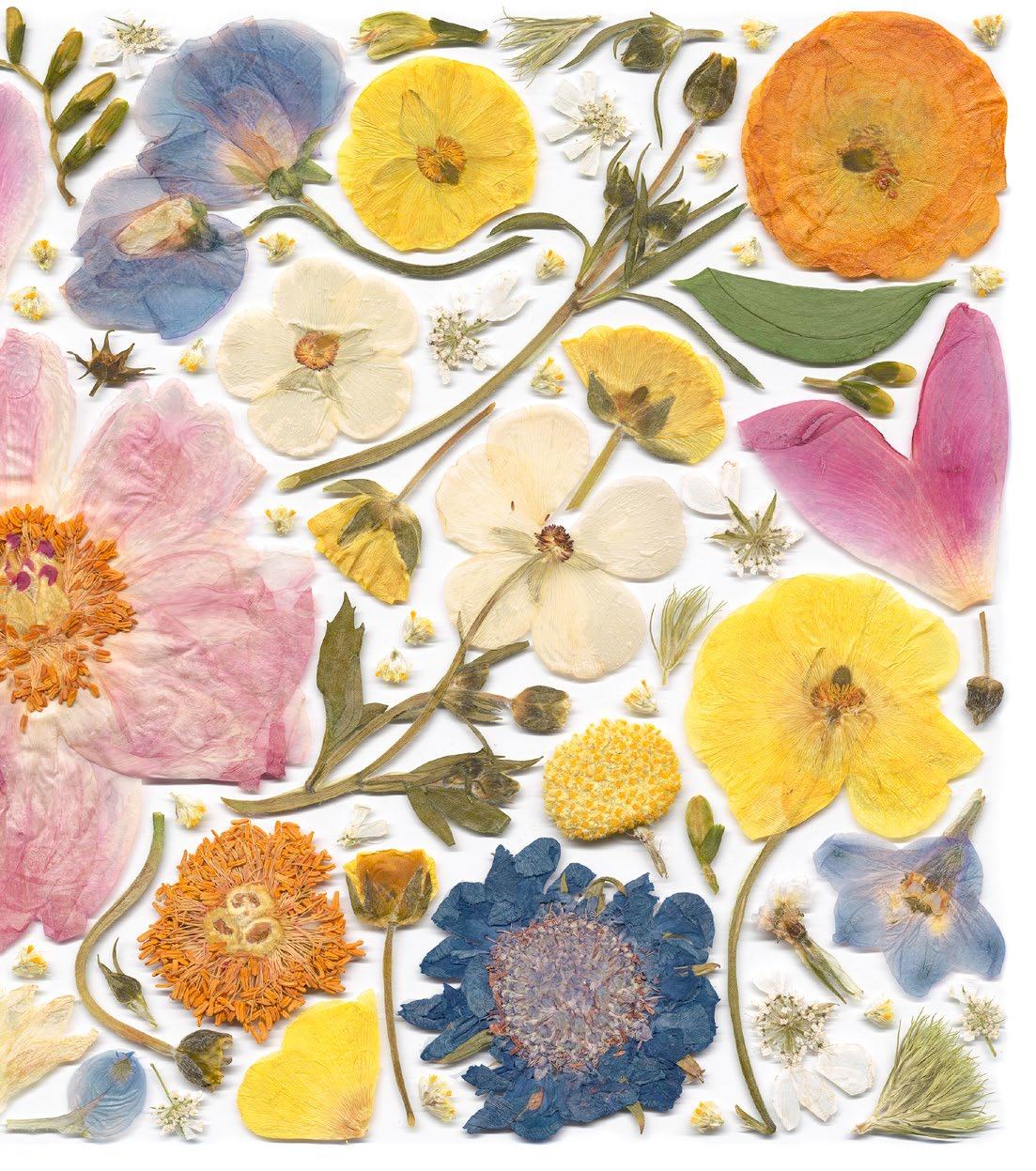
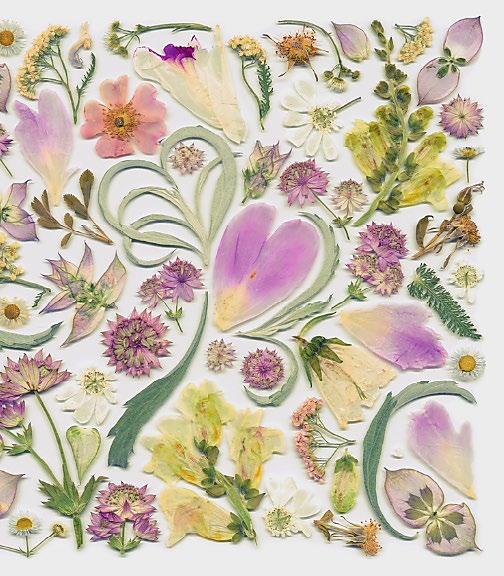
Wedding and event florist Holly Lukasiewicz of District 2 Floral Studio in Omaha, Nebraska, views pressed florals as an extension of the wedding design services she offers couples. To date, all of the couples who have booked District 2 Floral Studio for their 2025 nuptials have added the option to press their flowers.
Like Kate Punnett, Holly is pressing flowers which are then photographed and digitally scanned, which allows for printing multiples, such as for her line of note cards that spells out LOVE in petals, stems, and leaves. She’s also leading two-hour flower pressing workshops at Omaha’s Lauritzen Gardens, teaching students composition methods to create a one-of-akind, nature-inspired framed keepsake.
District 2 Floral Studio’s website devotes a section to “flower preservation,” which also attracts people who didn’t hire Holly to design their wedding florals, but who want her to transform a bouquet into pressed art. Other commissions are for special occasions, anniversaries, Celebration of Life gatherings, or to commemorate a client's seasonal garden's harvest.
“In so many ways, flower pressing helps us connect with nature and the world around us,” Holly observes. “Flowers will change a bit through the pressing process, but they hold similar qualities and capture a special moment in time that people can cherish into the future.”
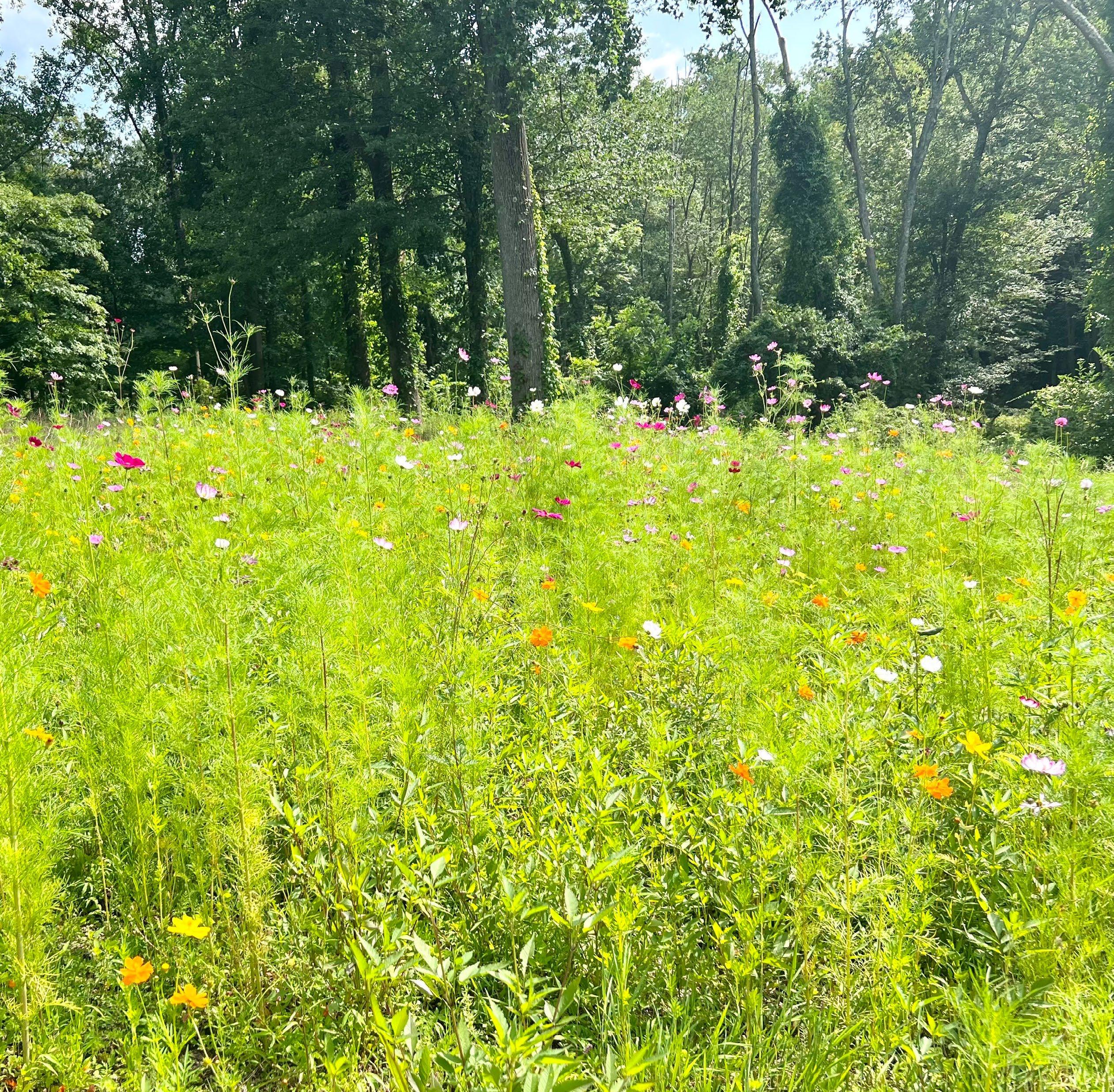
Homeowners have been moving away from perfectly groomed, emerald green lawns, thanks in large part to the “no mow” and “re-wilding” efforts taking hold in neighborhoods across North America and in Britain. There are many benefits to shrinking our lawns, including habitat creation and regenerative gardening, so we’re here for it. Whether you are planting a micro-forest or replacing a conventional patch of turf, the community-at-large is growing greener on the homefront and backyard.
Our 2024 Forecast included “Native Flora,” an insight which highlighted the work of members adding native plants to their crop mixes and incorporating native perennials into their floristry. For 2025, “My Own Ecosystem” is natural progression of “Native Flora,” both timely and nurturing, as many people want to retreat from news, politics, and everyday stress to embrace a safer, calmer, and more mindful lifestyle. Help clients find solace, and ways to control their personal worlds. Whether through workshops or services, you can teach them how to create their own, eco-friendly environment.
It’s a successful facet of Xenia D’Ambrosi’s offerings through Sweet Earth Co. In addition to growing and selling cut flowers and herbs, Xenia designs and teaches clients about various forms of eco-gardens, including pollinator gardens, native gardens, cutting gardens – and meadows. She has installed a flower meadow at her farm in Pound Ridge, New York, and has planted meadows of various sizes on clients’ properties.
Most garden owners approach Xenia to help them create a landscape that’s more eco-friendly. Her consultation includes a property audit, with various options for improving a garden’s sustainability. Meadows are often a solution to replace large (or smaller) lawns, or areas that have become overgrown and unmanageable. While highly
BY THE NUMBERS
From the National Gardening Survey 2024
12%
According to the 2024 National Gardening Survey, 12% of gardening adults converted some part of their lawn to a natural or wildflower landscape.
+5.3%
The five-year trend analysis shows that conversion of natural or wildflower landscapes grew at a +5.3% annual compound growth rate (CAGR) between 2019 and 2023.

We’re thrilled to announce our inaugural Slow Flowers Worldwide Summit. With a new, online format, the event builds on the success of our first seven Summits, all held as live, in-person conferences.
The Worldwide Summit will take place over three days early in the New Year. These dates are timed for floral professionals and flower lovers to fill their toolboxes with skills and techniques, and to uplift their goals and ambitions for the coming season. The program format includes 15 floral education sessions and round-table panels with international sustainable floral leaders, as well as bonus content from special guest presenters.
We are excited to go big internationally – making this an inclusive, accessible, and affordable conference, without the added cost of travel and lodging. Slow Flowers Society has partnered with Great Grow Along to produce the Slow Flowers Worldwide Summit.
Learn from these amazing speakers:
Briana Bosch
Holly Heider Chapple
Becky Feasby
Melissa Feveyear
Kristen Griffith-VanderYacht
Natasa Hansen
Kirsten McMahon
Hannah Morgan
Toni Reale
Sarah Statham
Amy Stewart
Eileen Tongson
Mara Tyler
Shanda Zelaya
Pilar Zuniga
useful for soil health, pollinators, and habitat, the idea of a meadow is also romantic.
“It’s such a dreamy, ethereal thing where people see themselves frolicking amongst flowers in their meadow –and they all want one,” she said.
Xenia’s own meadow is a mix of annuals that selfsow and cool season flowers and herbs. It’s a visually beautiful area, but it is also used as a cutting garden. For a recent client project, Xenia installed a 7,000-squarefoot meadow composed mostly of flowering perennials and grasses, part of a three-year process to fully establish.
Teaching clients about planting and maintaining meadows is now an ongoing service of Sweet Earth Co. “People often think it’s a no-maintenance solution, where we can just throw out some seeds and watch things grow. But I have to educate customers on finding the right site, evaluating the topography, tailoring the mix of plant materials – grasses, perennials and annuals. It involves planning, installation, maintenance, but more importantly, managing clients’ expectations. A meadow is never at a standstill. It is always evolving, and it changes from year to year.”
Unless there’s a budget to purchase large plants, the idea of an “instant meadow” is unrealistic, Xenia pointed out. After a period of site preparation (which inevitably means lawn or brush removal), the meadow planting involves seed mixes augmented with plugs or small plant starts. By the third season, perennials are established and begin to bloom more reliably, she says. “The landscape designer or gardener needs to value their time in doing the ongoing work, because you do have to keep coming back. It’s not a one-and-done kind of thing.”
How Eco-Friendly is Your Garden? (PDF)
Here are 5 steps, courtesy of Sweet Earth Co. This process often begins during the fall to prepare for a spring meadow.
1. Conduct a Site Assessment. Select a location for your meadow and determine its topography and soil composition. Note existing vegetation.
2. Select and Source Your Seeds and Plants.
Select a mix of native grasses (40%50%), flowering perennials (40%50%), and self-seeding, flowering annuals (10%-20%). Determine whether you will also plant plugs in addition to sowing seeds. Source your seeds/plants well in advance to ensure you have them on hand when necessary. Seeds can be stored in a cool, dry place until used, such as a home refrigerator.
3. Determine Installation Method and Prepare Your Site. There are various organic and nonherbicide methods of preparing the proposed area for meadow installation. They include solarization, repeated shallow cultivation, sheet mulching, and sod removal. Your installation method will be determined by factors of time, size of area, budget, and weed pressure. Often more than one strategy for establishing a meadow is needed.
4. Establish Your Timeline. If you decide to start in the fall, establish all the tasks needed for the project and the timeframe, from fall through the following spring; and in year one through year three.
5. Manage Client Expectations. It is important to clearly communicate the timeline and process with clients. While the meadow may be lush and full of color in year one, progress is not so visible in year two. Meadows are slow to establish and are always changing.
If you open your fields to flower lovers, they will come.


NOTE: This article originally appeared in JSS Advantage and online at johnnysseeds.com.
I reached out to five expert growers to learn more about their U-Pick programs and discovered that there’s a lot to know as you evaluate the pros and cons. I learned volumes from Susannah Calhoun, of Calhoun Flower Farms in Las Cruces, New Mexico; Randi Greiner of Beezie’s Blooms in Milaca, Minnesota; Chelsea Willis of Sweet Delilah Farm in Portland, Oregon; Melanie Harrington of Dahlia May Flower Farm in Trenton, Ontario, Canada; and Sarah Daken of Grateful Gardeners in Poolesville, Maryland.
WHEN AND HOW
Unless you find yourself with excess production and need to convert unsold flowers into instant revenue, it’s good to start with a plan, say the flower farmers. The “plan” should begin with listing reasons to open up your farm to U-Pick events. Because so many flower farmers also live on their farm, this is an important consideration – for family privacy, liability, and potential damage to crops, and many other reasons. Each of the growers with whom I spoke say that it’s important to set policies from the start, including when you open the gates and where the guest experience occurs on your farm.
There are growers who plan for summer U-Picks and others who view it as an end-of-season option after other sales channels wrap up (such as weddings).
It's the farmers’ prerogative to design a U-Pick program to suit your lifestyle, says Melanie Harrington of Dahlia May Flower Farm. She sets and posts a schedule of
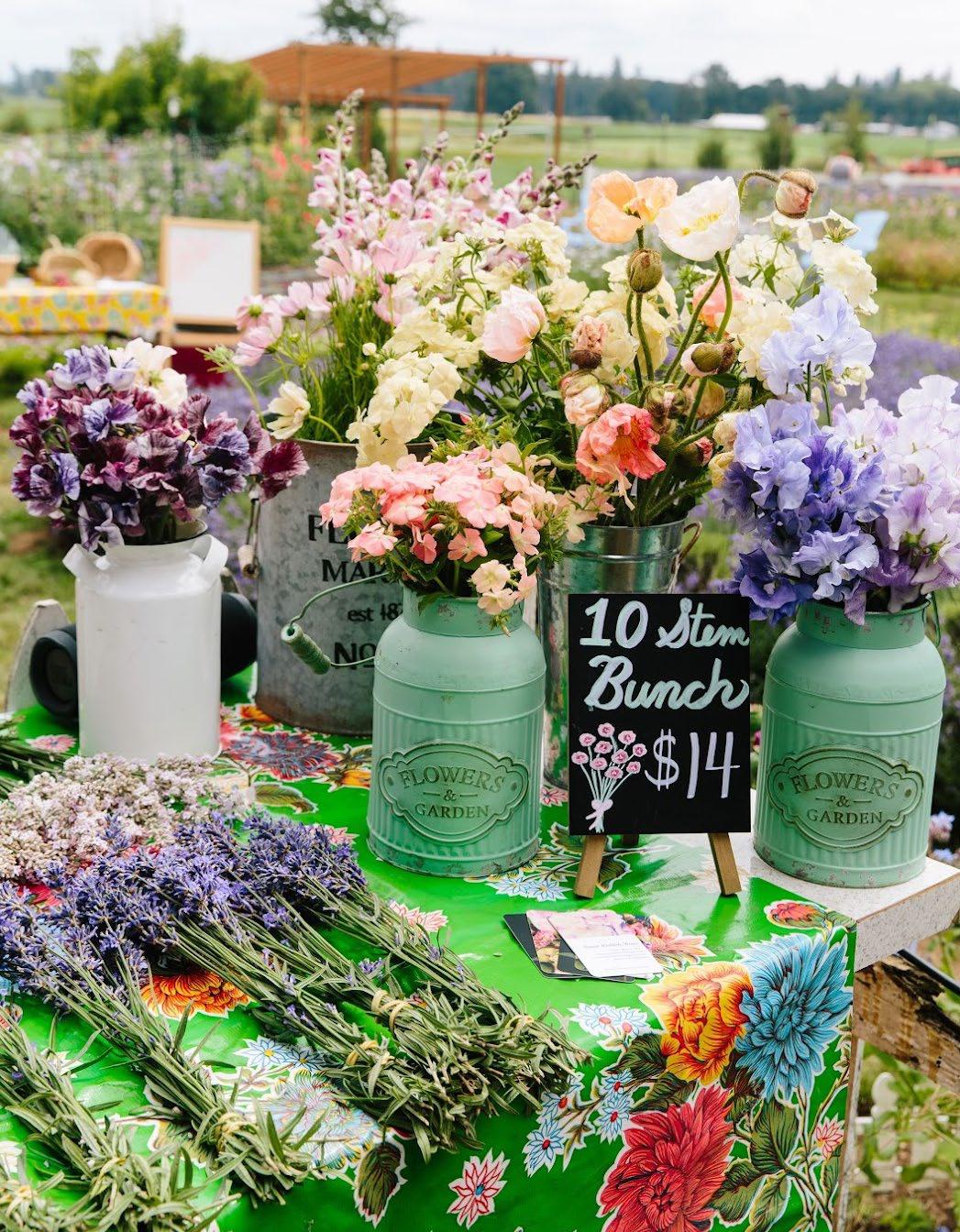

about 20 events during the summer months (usually on Friday evenings), selling tickets much like a workshop. “It is a class that runs from 6 to 8 p.m. It’s not a drop-in experience,” she said. “We ask folks to come 15 minutes ahead of time so we can check them off of our list, get them settled, and show them where the fields are.”
With three small children, Randi Greiner of Beezie’s Blooms decided to set up her U-Pick as a self-serve option, open from sunup to sundown, seven days a week. “Last year, we allowed people to come on Fridays and Saturdays, but I realized that was too limited. This year, we set it up so people could come every day, and it was just a lot easier,” she said. The farm is well situated on a highway traveled by vacationers, enabling Beezie’s Blooms to capture weekend customers, while parent-child outings and community groups often come during weekdays.
Sarah Daken and Tom Precht of Grateful Gardeners have found it best to schedule several 2-hour U-Pick slots in a given day –each with a specific start and end time – to ensure that customers arrive on time, ready for the fun. They limit the number of U-Pick tickets to 40 per time slot, which also helps with crowd control and parking flow.
At Calhoun Flower Farms, Susannah Calhoun has experimented with a number of U-Pick options over the past seven years, but most recently, she scheduled four events per month – the first and third Thursday evenings and Saturday mornings, spring to fall. She observes that the varied time slots attract different customer demographics.
Some of the most important planning revolves around planting specific flower beds, rows or fields for U-Pick use.
“I keep it really simple (and cheap) with summer annuals,” Melanie said. “Sunflowers, zinnias, amaranth, marigolds, and celosia are the bread and butter of it. If I want to get fancy, I’ll plant ‘White Lite’ sunflowers!” While she doesn’t specifically plant foliage crops for U-Pick, Melanie tells guests they can forage from her hedgerows for grasses or greenery. “I’ve caught them harvesting actual weeds for their vases,” she laughed.
When Grateful Gardeners first offered U-Pick, it was at the urging of Ellen Seagraves, a florist client, who asked them, “Have you ever thought about having people out here?” After Sarah and Tom expressed hesitation, Ellen continued: “What if you just did it at the very end of the season?”
The conversation inspired Grateful Gardeners to host a U-Pick dahlia event in 2023. “That was the best day we had on our farm the entire season,” Sarah recalled. “I’ve never seen so many smiles and so much joy. It’s what we needed to experience in order to try it again.”
When planning for 2024, they planted twelve 100-foot rows of annuals, including zinnias and celosia. “Even though we established the area for U-Pick only, we had so many cut-and-come-again varieties that those rows also became a revenue source for our farmers’ market, too,” Sarah said. The addition of annuals allowed Grateful Gardeners to offer two crop options (priced differently), with annual U-Pick events in June, July, and August, followed by four dahlia U-Picks in September.
Beezie’s Blooms devotes three 100-foot rows for its U-Pick program, also planted with

COMING MAY 6, 2025
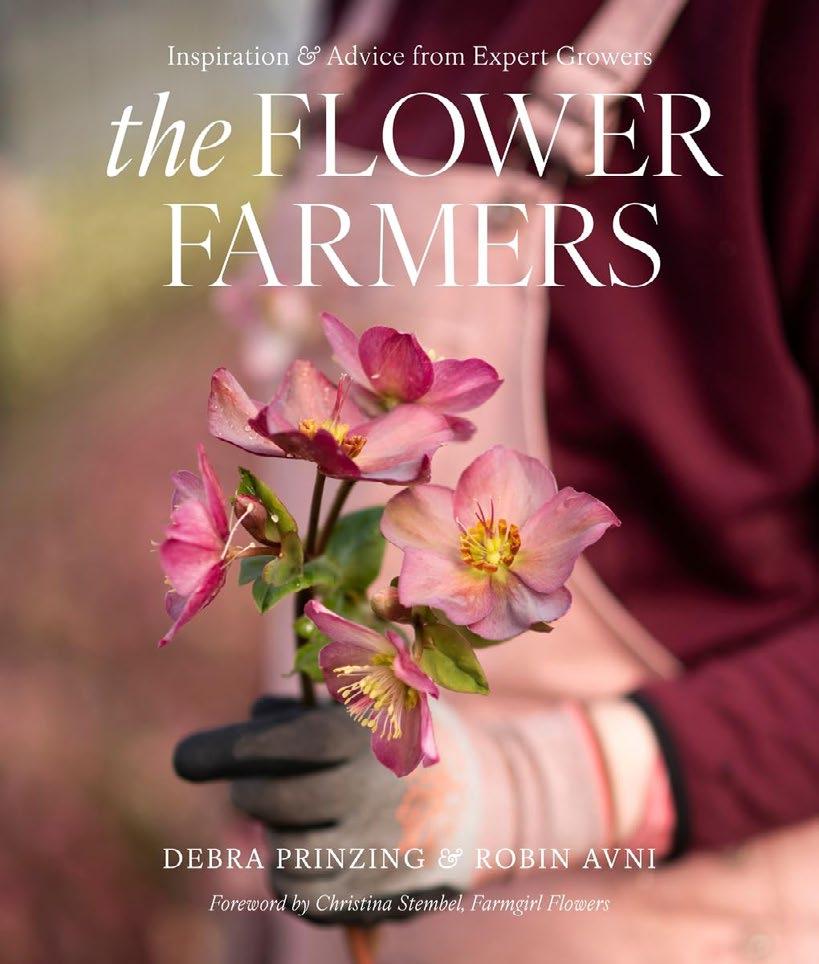
cut-and-come-again annuals. “I initially plant about two-thirds of each row at the beginning of the season, and then I leave a gap for some fresh plantings, so we can keep the fields open later in the summer,” Randi noted.
Susannah likes single-variety U-Picks, allowing her to plant and program for specific crops, including marigolds and sunflowers. Calhoun Flower Farms also maintains a few acres of lavender for their U-Pick events.
At Sweet Delilah Farm, in addition to the lavender program, “I like to offer U-Pick at the end of the season when I’ve done all my other events,” Chelsea said. “That way, I can just let people pick in certain sections, like the zinnia and marigold rows. I also let them cut in my dahlia fields, except for the areas set aside for dahlia breeding.”
Because her farm is more workshop- and event-oriented, rather than focused on high-volume production, Chelsea said she’s been able to experiment with themed U-Pick events. “After eight seasons, I’ve found having an event niche more enjoyable,” she said. “For example, I’ll offer sunset yoga, followed by access to U-Pick. I get inquiries from bridal parties who want to pick flowers for their bouquets, so I offer that as a private event and in conjunction, I’ll cut their roses for them. We also have a U-Pick dye plant event, so people pick their flowers and then dye bandanas.”
Of the group of five growers I interviewed, there is a wide range of ticketing and pricing options, from Self-Serve to Reserved, PrePurchased slots. Each has its benefits and
each is structured to fit the needs of the farmer’s time. Some sell tickets on platforms like Eventbrite; many use their existing e-commerce platforms, such as Square Space, or use on-site payment options such as QR codes or even a cash box.
At Beezie’s Blooms, customers arrive at the U-Pick check-in stand where they scan a QR code to pay $30 for adults and $10 for children. There is a laminated information sheet for them to review and crates filled with Mason jars for adults and small paper cups for children, plus a bin with clippers. In the past, Randi has also used a cash box for U-Pick payments, but since the checkin station isn’t staffed, she dropped that option. She also books private group U-pick experiences and offers “Flower Fridays” after-hours events for a higher per-person ticket price.
At Dahlia May Flower Farm, U-Pick guests must pre-pay for their $50 ticket on a specific date, which Melanie likens to a concert ticket, meaning, no “plus ones.” “One ticket is for one person is for one bouquet,” she noted. “We limit our experience to 25 tickets for two hours. It takes two staff members to run the event – myself and one assistant. If there are 25 people who each bring their mom or husband or girlfriend – even if they are just here for the experience and don’t intend to cut flowers - we all of a sudden have to manage 50 people.” Once she explains the “concert” analogy to customers, they usually understand. The $50 ticket includes two hours to pick flowers, plus a glass vase for arranging their blooms.
For its dahlia U-Picks, Grateful Gardeners offers customers a $50 vase and a $150 floral
bucket option, which must be pre-purchased through the farm’s online shop (the annual U-Pick events are lower priced). “Most people buy the vase option, but when they get here, they decide to switch to a bucket,” Sarah observed. She marvels at the quantity of stems guests are able to cram into a container, regardless of its size. “I try to base the price on what would be a reasonable amount of stems to fit in the cylinder vase or bucket, and how much would that generally cost.” She estimates that some overeager guests walk away with $500 worth of dahlias for their $150 bucket fee. “But if we didn’t open up our farm to people, that revenue wouldn’t be here,” Sarah points out.
Sweet Delilah Farm customers pre-purchase U-Pick tickets for $15, which is good for a small handful of lavender or flower stems. They are required to bring their own clippers and a container with water for transporting flowers home. Chelsea offers eco-fresh wraps for people who forget a container. “I want to keep it really accessible. We’ve had a good turnout with this pricing and most people end up buying more stems, like dinner-plate dahlias. I always sell other items, like T-shirts, and seeds, so it’s like a soft up-sell.” Any related class or workshop has a separate fee and the $15 U-Pick is treated as an add-on cost.
At Calhoun Flower Farm, Susannah has experimented with a number of options over the years. U-Pick sessions and other events that include U-Pick range from 20 to 350 guests, and tickets must be prepurchased. Instead of a Mason jar, Calhoun Flower Farm U-Pick customers gather their stems in a southwest-style clay jar
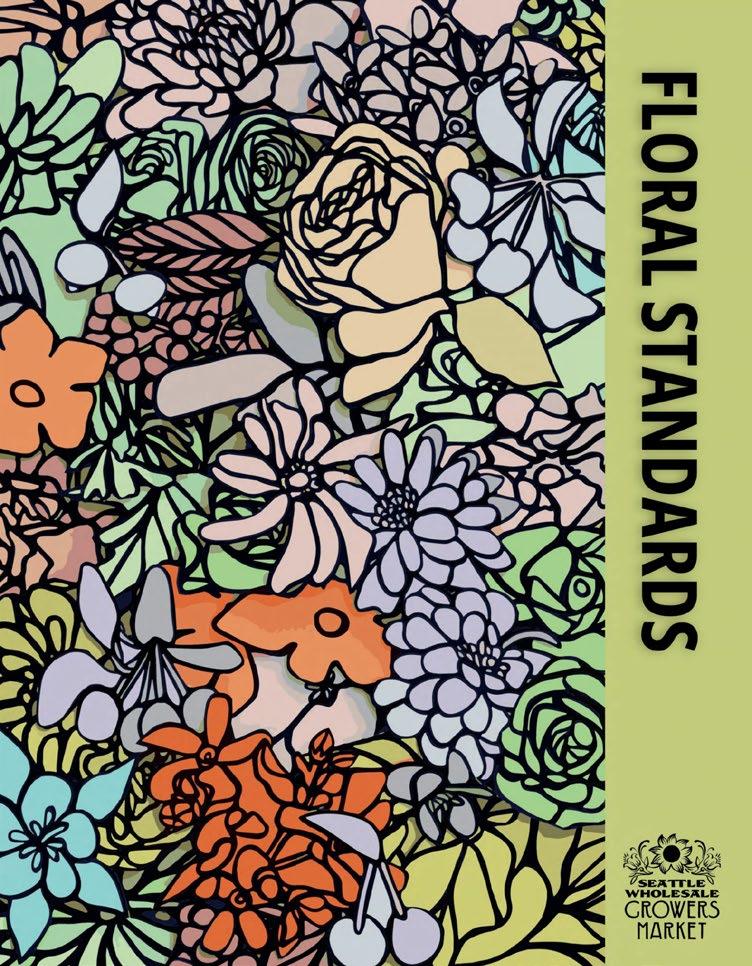
A practical guide for harvesting and delivering professional quality products
Written by FLOWER FARMERS for flower farmers, growers, and gardeners
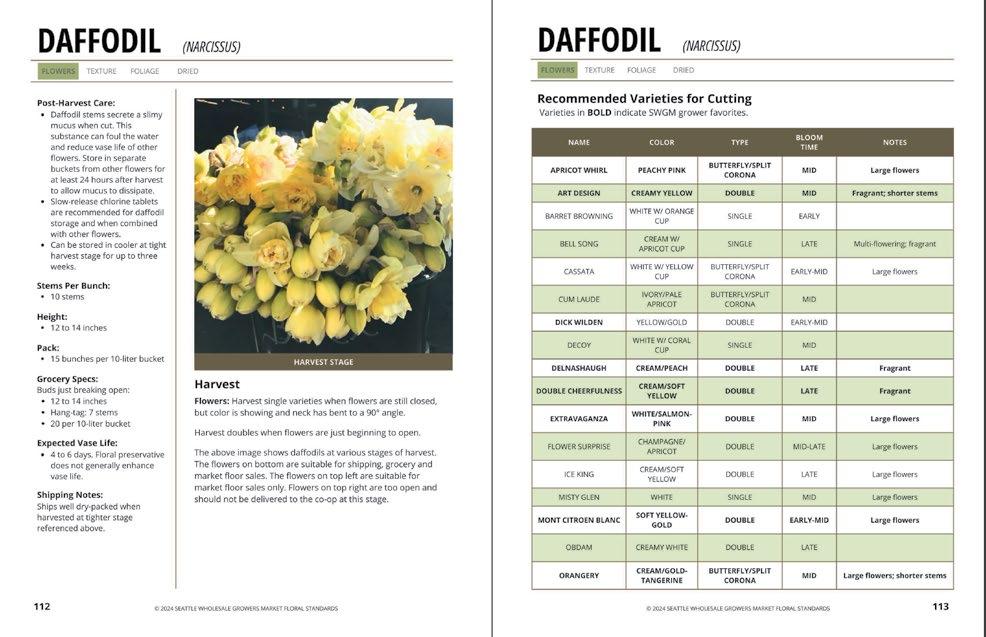
“This book is the missing link for flower farmers, both new and seasoned! Learning to grow flowers is one thing, but learning the specific ins and outs of what’s required in terms of quality and standards to sell flowers at a wholesalelevel is another skill altogether. Lucky for us, we don’t have to wing it anymore. Floral Standards will lift and strengthen our industry by helping farmers become pros.”
LENNIE LARKIN Farm Business Coach and author of Flower Farming For Profit
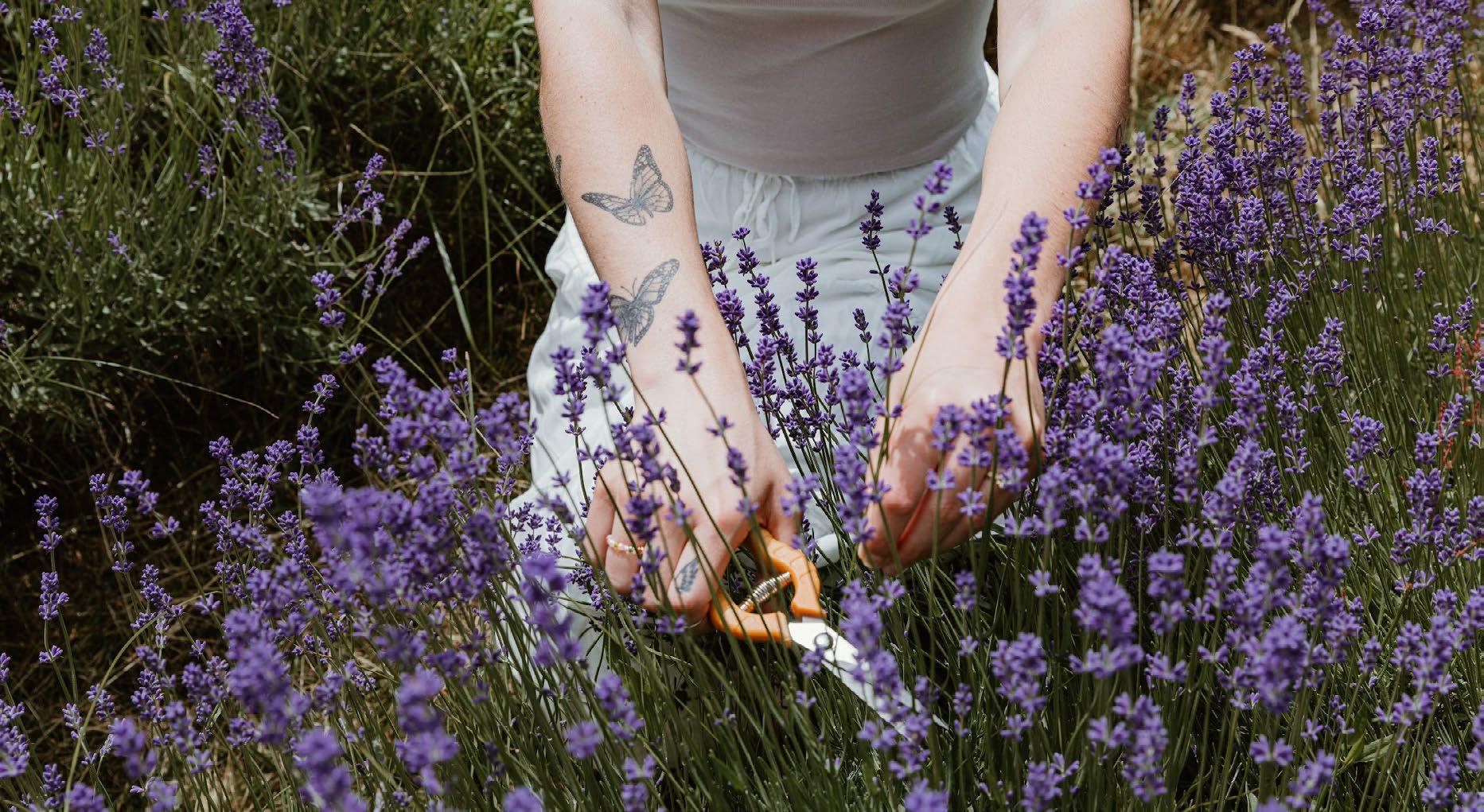
called a “Cantarito.” Depending on the jar size, customers pay between $20 to $45 for their U-Pick session. There is also a $65 full bucket option for DIY customers. The farm is planning to market 50 “flower pass” tickets, which will allow customers to attend all of the scheduled U-Pick events in 2025. “It will help us generate some funding in the winter,” Susannah explained. “I’m thinking of creating a brass or copper bangle bracelet that is personalized for each buyer.”
Ensuring that you, your farm and staff, and your guests are safe is a top recommendation from those I interviewed. “Make sure that you’ve got the right insurance,” Chelsea pointed out. “Every year, I have a conversation with my insurance person who asks, ‘how have things changed?’” Similar to homeowners policies, a farm can add eventspecific coverage to an existing policy, she adds.
You should also check local zoning regulations for on-farm events, Susannah suggests. She learned from her insurance agent that it’s best to schedule U-Pick sessions as private events. “People have to pre-book to come here and experience our flowers. We’re never open to the public; we don’t publicize hours,” she explained. Hosting U-Pick as a private event also factors into other items on her checklist, such as designing parking areas that comply with local zoning rules. “We have a licensed commercial driveway at Calhoun Flower Farms, but we would have to have so many other registrations and certifications in order to hold public events,” Susannah noted. “Guests are sent a YouTube video when they purchase their ticket, so they know how to harvest when they get here. We’ll go over the rules again when they arrive. I try and make it funny. I ask them how many fingers they have and how many fingers they’ll have when they leave. No one can come onto the
farm without checking a box that asks, ‘have you read the waiver?’”
Sarah said her “biggest nightmare” revolves around children. She allows guests to bring their children but does not allow anyone under 10 to cut flowers. Registration details state that U-Pick is not appropriate for children under 4 years old, and that the ground is not stable for people using walkers.
“When people arrive, they aren’t allowed to go to our field until they sign our liability waiver,” Sarah noted. “The form says that we are not held responsible for accidents on the property. Yes, we have insurance, but I want customers to remember that there is some inherent risk they assume when coming to a farm setting.” The waiver also gives a guest’s permission for Grateful Gardeners to use their likeness in any promotional materials, making it easy for Sarah to take and post photos of U-Pick experiences.
Dahlia May Flower Farm maintains a $2 million(CDN) liability policy. “When I see people asking questions about insurance in farming forums, my tip is to start with the company where you already have home or business insurance – and add extra insurance for U-Pick events,” Melanie said. Her other hot topic is to add as much programming structure as possible: “Take nothing for granted, because people are people. So lay things out in your ticket information – no pets, no smoking, no drinking, one ticket per participant.”
Good directional signage at the parking area and in the U-Pick fields help minimize other problems. At Grateful Gardeners, for example, Sarah and Tom attach brightly
colored flagging tape to the top of T-posts and dahlia cages to avoid potential injuries.
You can also tailor U-Pick events to make them safe for families. At Sweet Delilah Farm, Chelsea has a basket of plastic, kidfriendly scissors for younger guests’ use. Grateful Gardeners has added “Mommy and Me” midweek dates for parents and young children, while Beezie’s Blooms similarly hosts home school groups at designated times.
I’ve already touched on the importance of creating policies for managing your U-Pick event -- with or without pets and children. If you want guests to bring their own clippers, wear a hat and comfortable shoes, and bring a water bottle, tell them up front and often. And that leads us to restroom facilities. Most of the farms I interviewed rent a portable restroom for their farming season. It can be used by crew members, people who come for tours or workshops, and U-Picks. “We spend about $200 per month,” Sarah said. “And I don’t want anyone from the public coming into our house, so it’s money well spent!”
Chelsea at Sweet Delilah makes it clear that her farm does not have restroom facilities, but she admits there’s always one person who asks to use her facilities. Beezie’s Blooms requires professional photographers to book a separate time to use flower fields for photo sessions, which means U-Pick customers are not allowed to bring along their own professional photographer.

How one family has built a flower-filled life.
This year, Lina and I marked our tenth full season growing and selling flowers. Each season, we make changes to our mix of offerings, but our three main avenues of income stay fairly consistent: our weekly retail arrangements, sale of wholesale stems to Baltimore and DC florists, and mixed bunches that local retailers sell. The weekly retail arrangements are hand-tied bouquets available in pints and quarts, brought to customers’ doors in our county. The wholesale stems are offered by another farmer on her weekly availability list, and we pay a percentage of sales to her farm. And the retail bunches are sold by the bucket, directly to coffee shops, restaurants, and grocery stores. We only offer the retail bunches to places within a few miles of our farm. Living on a flower farm is great. All four of our teenagers have worked on the farm, which is a nice way for them to make a little money. Their commute is short, it gives them spending and saving money, and it provides a solid introduction to the working world. As the older ones have gone on to jobs in labs and offices at college, they’ve taken a strong work ethic with them. There are also tax advantages where we live for land that’s designated as agricultural, along with programs from county, state, and federal agriculture departments that help cover costs for infrastructure that provides an overall environmental or economic benefit.
Everyone who follows the Slow Flowers movement knows the benefits of sourcing from local flower farms. And during the pandemic we learned the added lesson there is no farming approach more resilient than this one. Our flowers remained available even during major disruptions of global trade.
Despite all these benefits, in our tenth season of growing and selling flowers, our gross farm income will be less than $35,000. Our farm income increases every season, but we are not on a growth trajectory toward replacing non-farm income for our household.
When I first pitched the idea of writing this article, I wanted to normalize the notion of farming as a “side hustle.” In our household, non-farm income is primarily from an off-farm job. That’s also where our family’s retirement savings and health insurance come from. My thinking was, “Let’s talk more about how this works.” I knew we weren’t the only growers balancing farm and non-farm work.
Lina and I workshopped the idea together, and we spent some time investigating what other farms do, and digging into data. We talked with other cut-flower growers in our local growers association.
The story that began to emerge came as a big surprise to me. We weren’t nearly as unusual in our approach as I assumed we were. According to the USDA Economic Research Service, “Small family farms account for 86 percent of total farms, with gross cash farm income less than $350,000. The households operating these farms typically rely on off-farm sources for the majority of their household income.” Our way of farming isn’t unusual at all! In fact, it’s by far the dominant approach in this country.
Small farm households in the U.S. overwhelmingly rely on non-farm income. Even though it’s what we’ve
This picture is a little different than we imagined when we started our farm.
But it’s been a good lifestyle for our family.
been doing for 10 years, I didn’t have any idea that it was the same approach taken by the supermajority of farm households. I don’t think most people know this. At a guess, most farmers don’t even know it.
The more Lina and I talked about it together, the less sense it made to talk about our farm as a “side hustle.”
It’s just farming.
This is the way most farm households make ends meet. It’s how we fund our retirements and pay for our insurance, and it’s how we put kids through college. Perhaps more to the point, it’s how we farm.
I attended a meeting of our local cut-flower growers association in the fall, alert to my new reality. I’ve started paying closer attention, and I hear a lot of self-doubt from farmers growing at a small scale trying to fit it around another job. What I wish I
could say to every farmer who utters those words “not really a farmer” is that they’re just like the other 86% of us.
I’m not trying to make the argument that this is a good sign of a healthy and well-balanced society. An economy where small farms could reliably provide a good living for farm households would be truly wonderful. But it’s not the one that we’ve got right now.
Government programs and social change will help us grow in this direction, but those are a small part of the equation compared to farming itself. It’s us farmers who need to figure out how to grow in a way that can actually work for the world we live in. For most of us that involves balancing farm work with other means of generating income.
This picture is a little different than we imagined when we started our farm. But it’s been a good lifestyle for our family, and in fact there’s also a pleasant surprise lurking in the data: median total household income is higher for farms than for others!
I hope this inspires at least one person to consider whether farming might be something they want to try, and I hope it inspires all of us who are already growing to remember we are just farmers.
Slow Flowers aims to reconnect flower consumers and floral professionals with the source of their flowers. We believe that when the origin of all botanical varieties sold to consumers and florists is clearly labeled, we place higher value on local, seasonal, and sustainably grown florals, used artistically to express beauty.
1. To recognize and respect the seasons by celebrating and designing with flowers when they naturally bloom.
2. To reduce the transportation footprint of flowers and foliage by sourcing as locally as possible.
3. To support flower farmers small and large by crediting them when possible through proper labeling at the wholesale and consumer level.
4. To encourage sustainable and organic farming practices that respect people and the environment.
5. To proactively pursue equity. inclusion. and representation in the floral marketplace. intentionally valuing Black floral professionals and farmers. floral designers, and vendors of Color in our business practices with as much support as we give to environmental sustainability.
6. To eliminate waste and the use of chemical products in the floral industry.
The Slow Flowers Movement puts a priority on sourcing local and domestic flowers. In a way, this also means that we redefine beauty. As a Slow Food chef cooks with what is seasonally available, a Slow Flowers florist designs with what is seasonally available.


